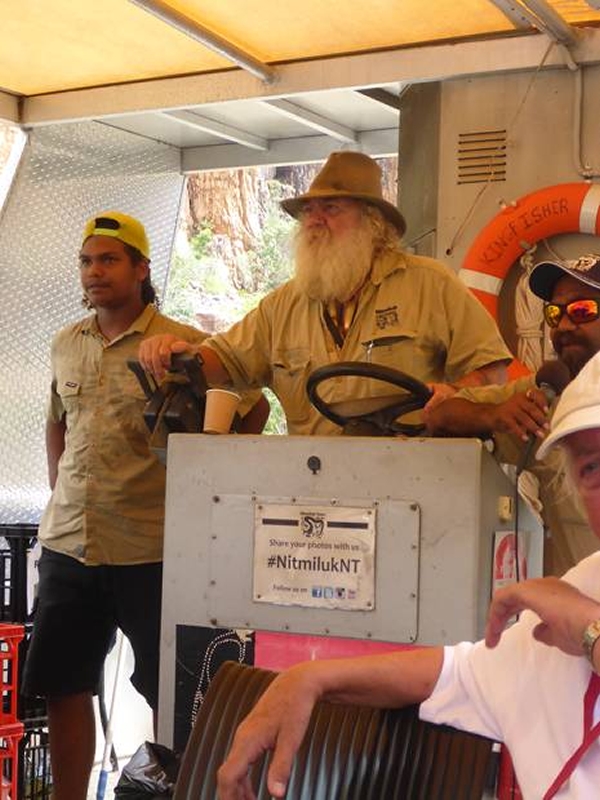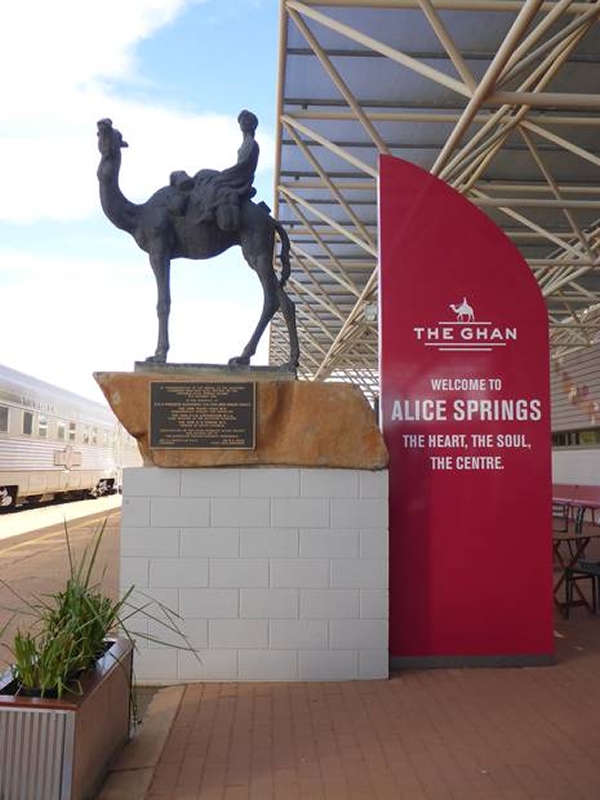Silently Rests the Silver Snake
There was hardly a sound outside as I left the Parkland Station lounge full with bubbly and orange juice sipping adventurers for the sweltering, sun filled platforms. Our train was so long, at one kilometre, it took up two platforms; 39 carriages included the engine, two power wagons, a motorail wagon with four cars, crew quarters, dining carriages, lounge carriages and our 27 guest compartment carriages. At really busy times the Snake extends to 31 guest carriages.
For fear of being questioned about my limp and so my fitness for the trip I had taken two paracetamol to deaden the pain. I needn’t have worried, folk with sticks and in wheelchairs were easily accommodated. Beside we’d checked in so there was no going back now! I could limp along the platform to my heart’s content.
A team of lady window cleaners was busy, one sponging, another squeegeeing and the third mopping up droplets and checking for perfection. I could just see the end of the train, a fuel tanker with its umbilical cord extending to the far platform. “How much fuel are you loading?” I asked one of the overall clad guys.
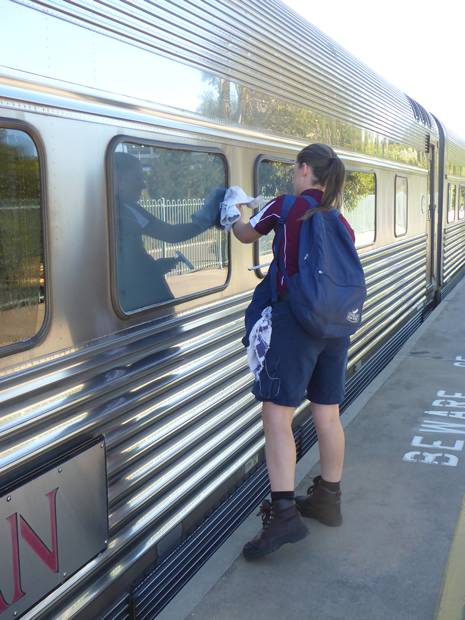
“2800 litres in 3 fuel tanks, that’s 8400ltrs which would get us almost all the way to Darwin but just to be sure we re-fuel in Alice Springs and she uses more the hotter it is.”
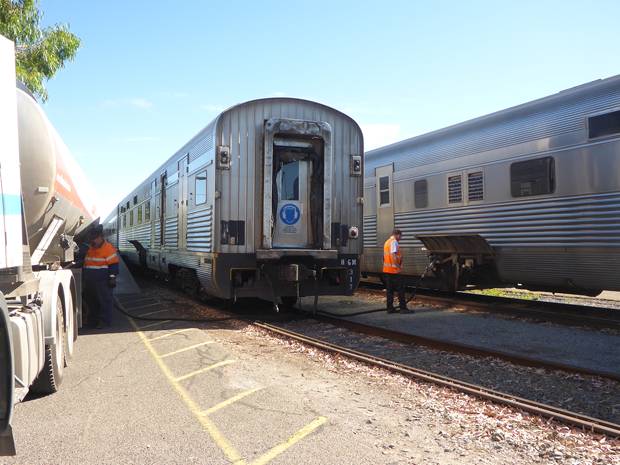
A few more travellers had ventured onto the spotless platform to take photos in front of the evocative cameleer logo. We took it in turns to ‘shoot’ eachother.
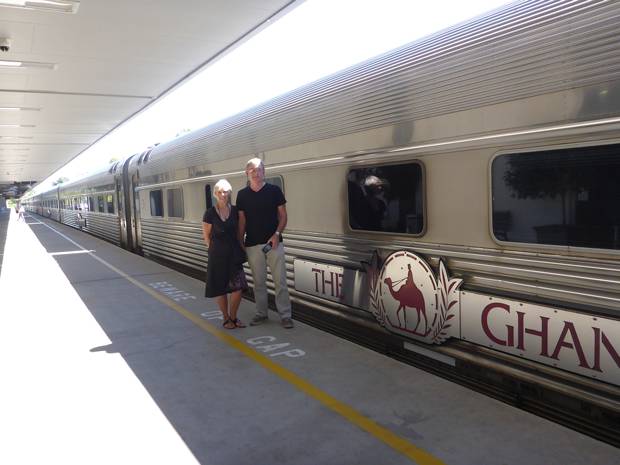
Back in the lounge the airport style check in was nearly complete, trolleys of empty champagne bottles clinked their way to the re-cycle truck, the last drops of drink were swallowed and with relaxed organisation we made our way to our allotted carriages, our luggage already installed into our cool cabins.
At ten past midday as the sun started its descent we moved slowly forward, reversed to pick up our other carriages and started out on our 2979km journey northwards.
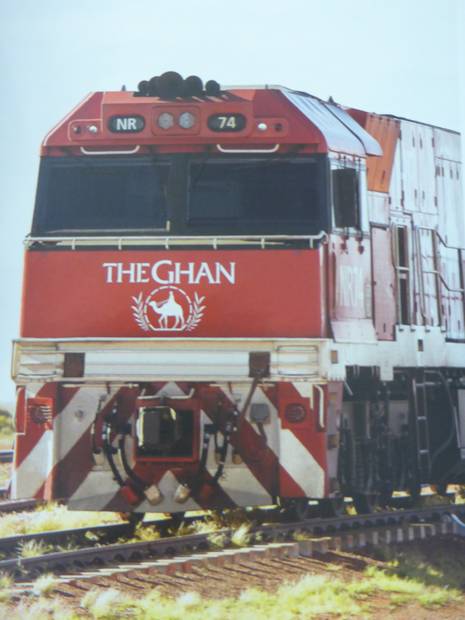
Soon we learned that because of the extreme temperature of 45’ the Simpson Gap walk through the West MacDonnell ranges had been cancelled but such was our level of anticipation any disappointment we might have felt was immediately replaced with wondering what we would do instead.
Suburbs and wheat fields dotted with the wind turbines of Snowtown Wind Farms were soon replaced with the pretty coastal beaches and resorts of Port Pirie, Port Germier and Mambra Creek along the shore of Spencer Gulf. A little further on at the head of the Spencer Gulf is Port Augusta, gateway to the 430 km long Flinders Ranges now looming purple with growing dark shadows as the sun moved over them.

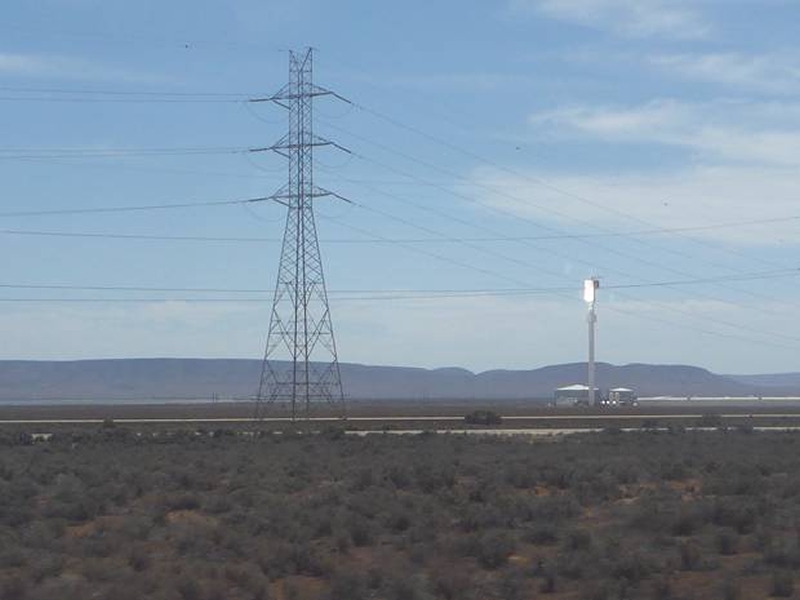
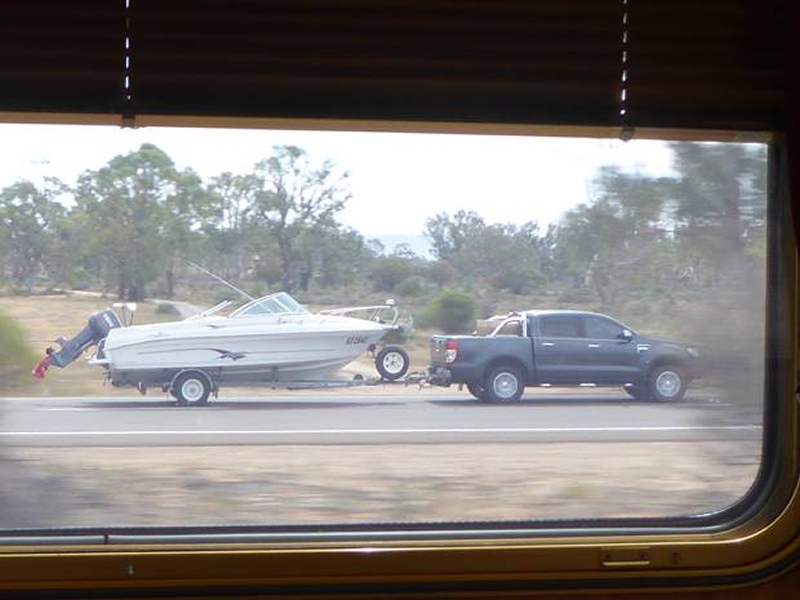
Pink dust roads disappeared over the hills and horizon to who knows where. Vast harvested fields with a few sheep and cattle cleaning up the residue of the crop munched away oblivious to the red dust twisters that rose like smoke plumes around them. Prickly spinifex dotted the red earth and two grey kangaroos looked in astonishment at our silver shiny snake moving slowly past.
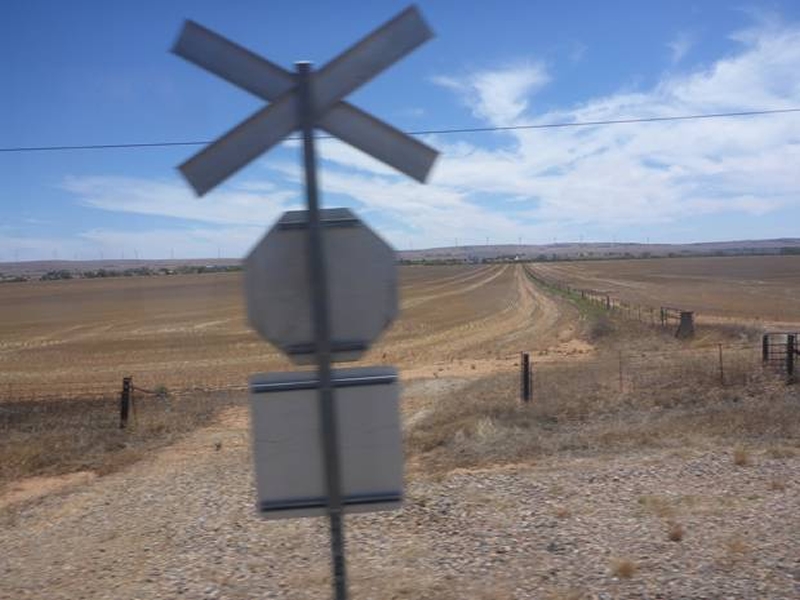
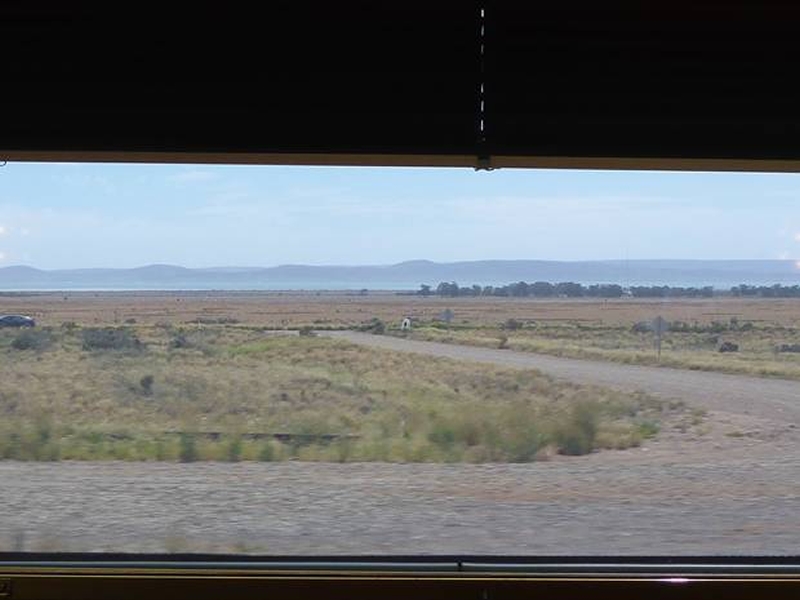
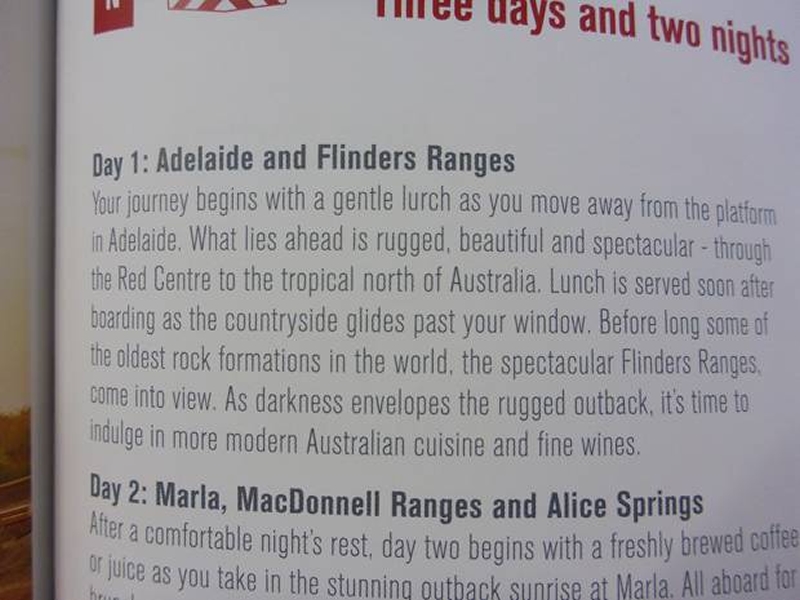
We were allotted 1.30pm for our lunch slot and joined our fellow travellers in the lounge just before venturing into the lovely art deco Queen Adelaide Restaurant. Being shown to our table of four with two complete strangers 7 times on the journey was an excellent way to be reminded just how interesting other folk can be. We dined twice with a couple from the East End and in conversation discovered that they met at the age of 15 on an educational cruise on the B I Line Nevasa around the Baltic the same year that my fellow pupils and I enjoyed a Christmas trip on her around the Med and Holy Land.
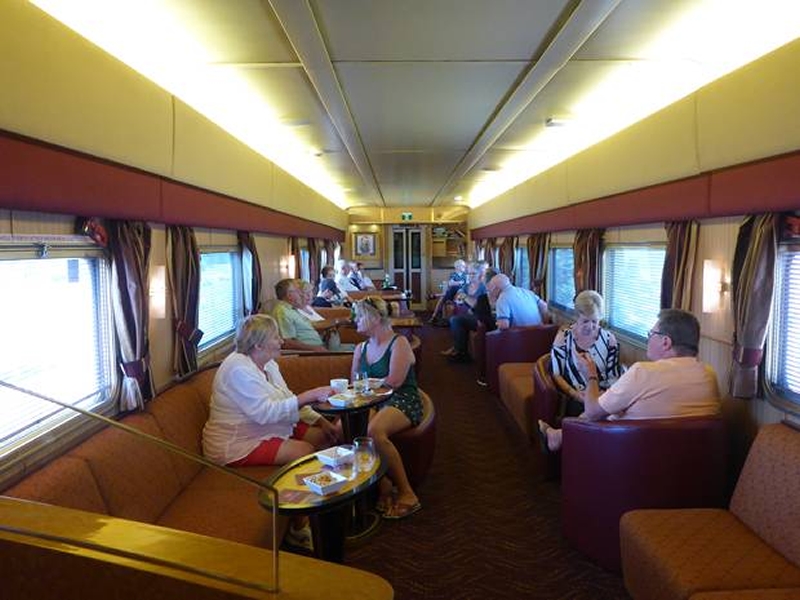
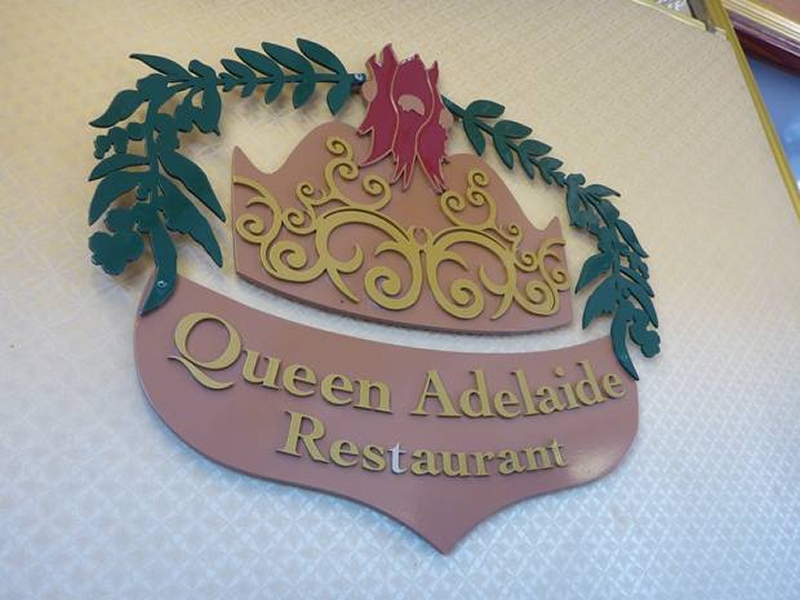
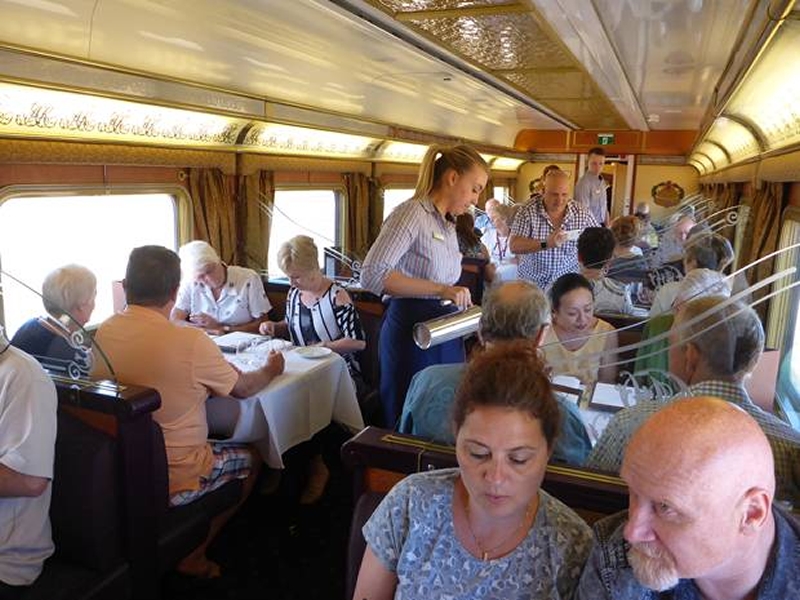
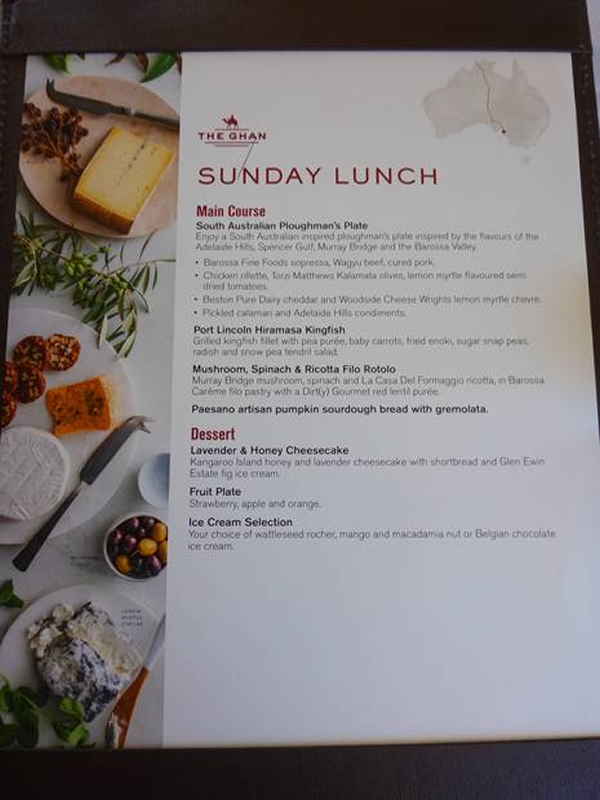
Another couple run a website that organises walks from a variety of starting points along the Pilgrim road, Camino Real to Santiago da Compostella in north-west Spain. An American married to a Japanese lady had like us chartered yachts from Sunsail and over the years owned a variety of their own sailing yachts.
After a tasty meal of mushroom, spinach and ricotta roule with artisan pumpkin sourdough bread, lavender and honey cheesecake and ice cream, washed down with our favourite wines and a good chat we were ready to just relax in our cabin with our complimentary brandies and watch the beautiful scenery pass by. I think I exceeded my weekly recommended amount in around 3 hours!
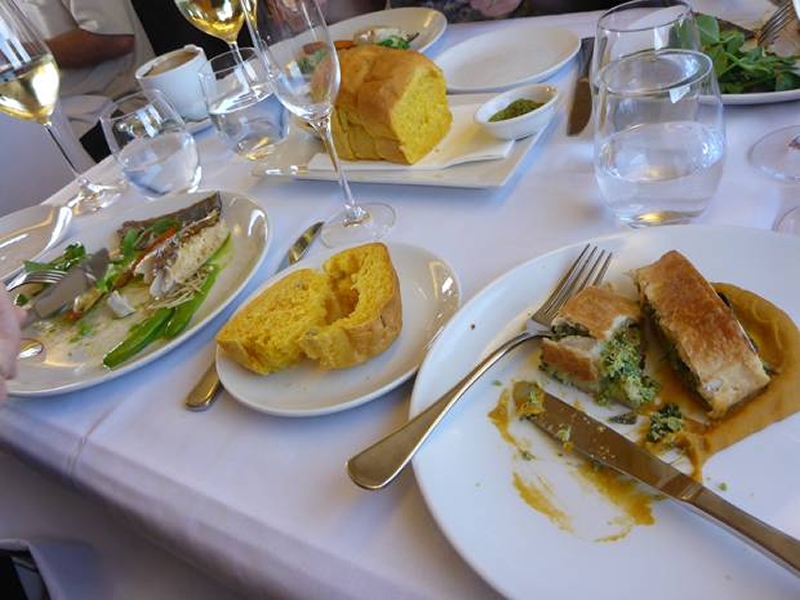
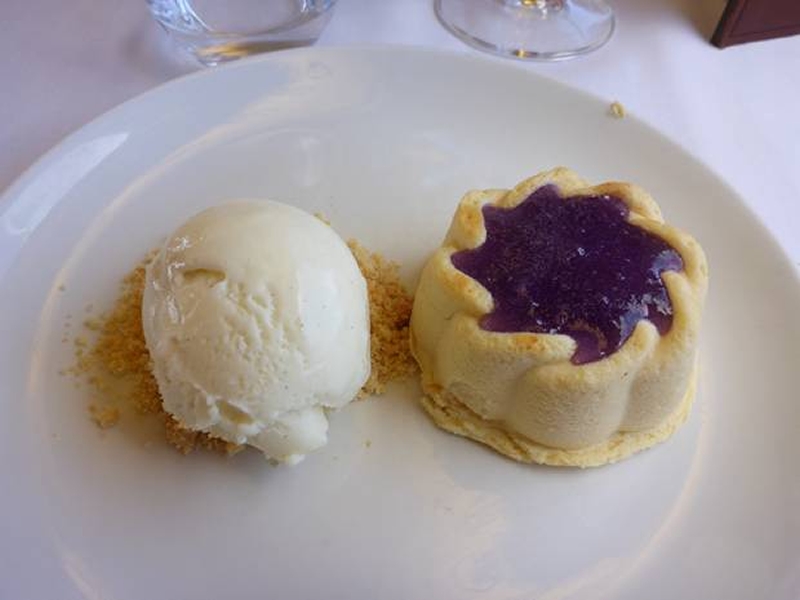
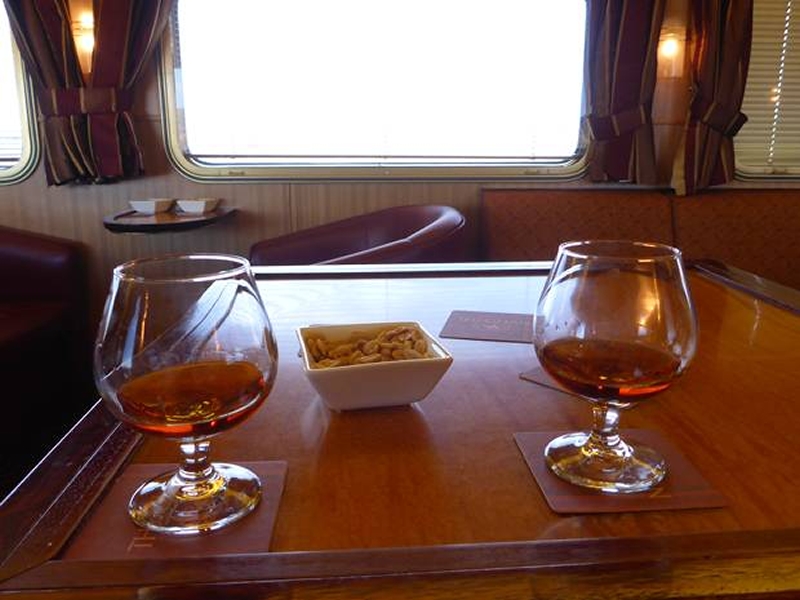
We found channel 5 on the radio broadcasted interviews with interesting people. A woman who as a child wanted to be a nurse with the flying doctors and after years of marriage and raising her children found her family supported her all the way to fulfil her dream. Another story about the 1974 Darwin Cyclone, I remember that, and Barramundi fishing off the Gold Coast. Our door was locked, our feet up, Rob asleep, it was just me, the train, the stories and the outback.
Trees like puffs of green on sticks sitting in the beautiful warm ochre earth. The occasional olive grove and in the far distance mysterious arid mesas, table topped eroded volcanoes, the Adelaide River and arable hills now far behind us.
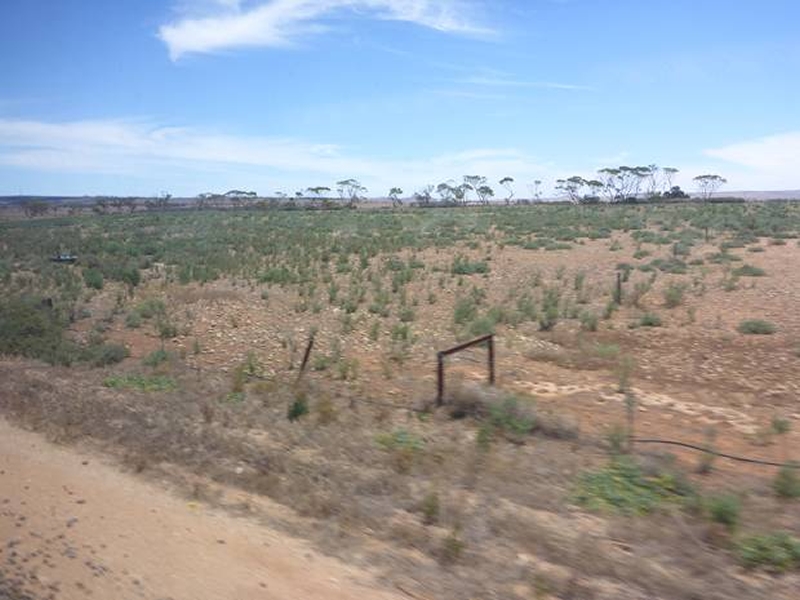
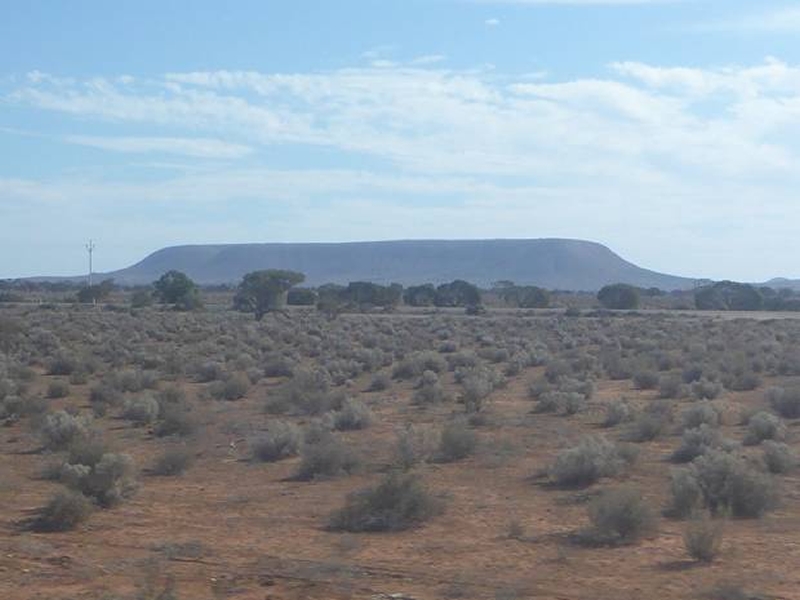
Our little cabin was comfortable and functional. Rob opted for the top bunk which gave me a view through the window from mine. The little ensuite was Zoonie sized and the privacy of our solitude was remarkable considering we were with 250 other outback onlookers, train trekkers in our shiny tube.

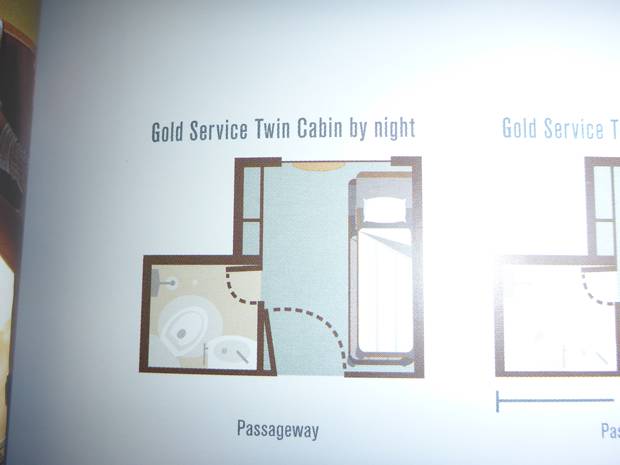
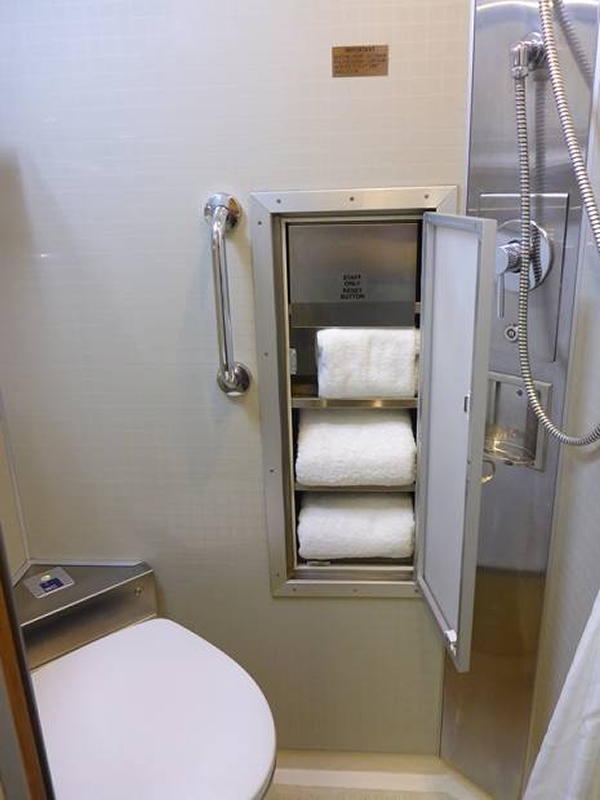
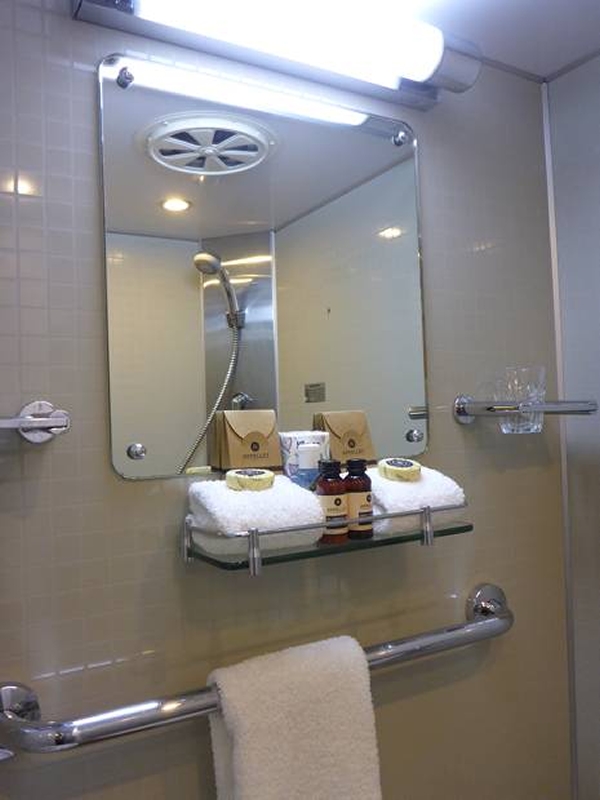
Droughts that can last for a decade have always been a problem for the farmers here and ruined houses stood testament to failed farming enterprises. Piles of sawn tree trunks, rusty vehicles and discarded tyres, lengths of railway track awaiting use and a pipeline lay alongside the track in the red soil. An eagle circled.
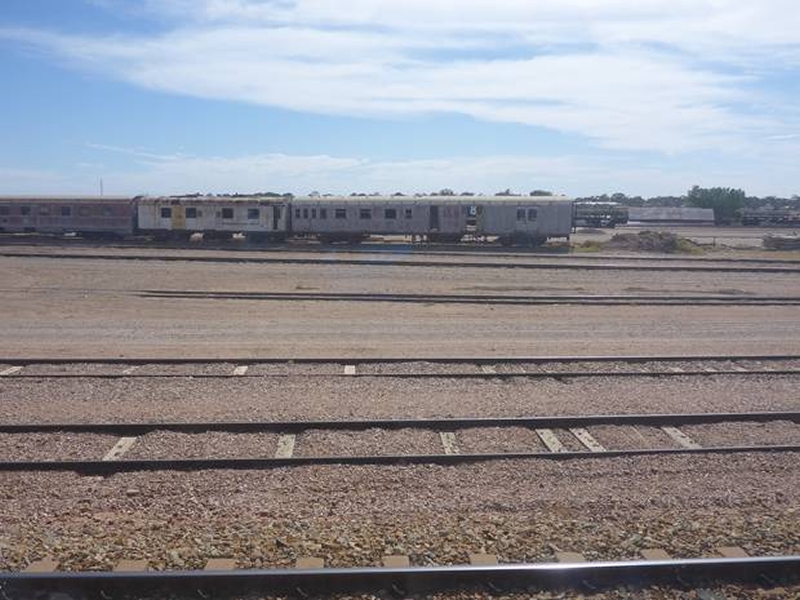
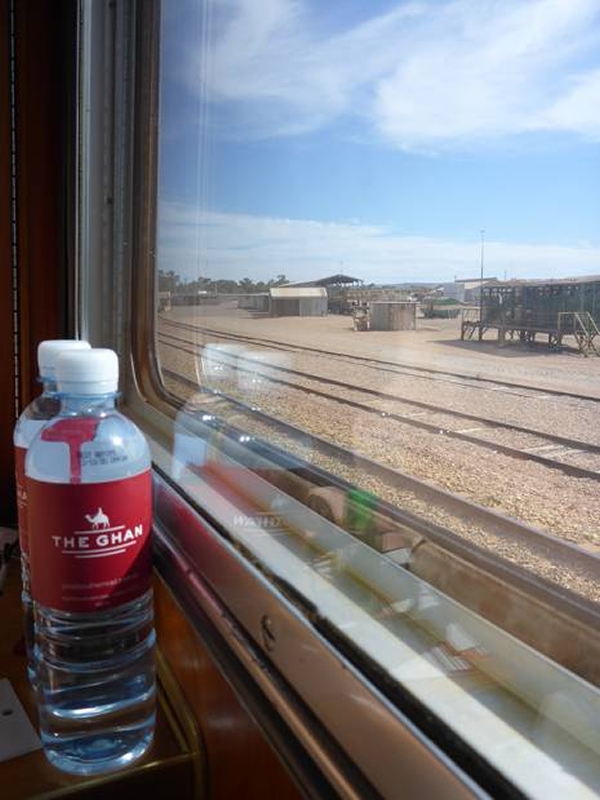
As my eyes darted from side to side I was reminded of the concept of time we feel when we start a voyage on Zoonie. Whatever we are doing, however we pepper our day with events and tasks Zoonie sails on 24/7 along her linear path carrying us onwards in our chosen direction. And so does this redheaded silver backed desert snake, the Ghan, from very slow with the odd stop to an average of 85kmph up to 115kmph and ever onwards but 24/7 no matter what we were doing.
Bookaloo, Winappa and Woomera we left behind and at Tarcoola turned right, away from the westwards route that heads to Perth and started northwards through Manguri Siding that connects Cooper Pedy, one of the richest opal mines in the world, with the outside world. Aborigines were amused by how the miners did and still do live underground to escape the heat. The aborigine term for this unusual habit sounds like ‘cooper pedy’ so the name stuck.
Known as the last true Australian explorer Len Beadell was responsible for opening up the last frontiers of central Australia and establishing a network of outback roads and the site of the Woomera Rocket Range between 1947 and 1963, but we passed by the latter during the hours of darkness.
Just a short walk from where I lived on The Isle of Wight and facing west from the Needles chalky outcrop is the Black Prince (I think that was its name, it’s a while since I visited) rocket engine testing site. From there the rockets were transported to Woomera for launching.
Supper seemed to happen very quickly after lunch, spinach gnocchi with rocket, pear, walnut and parmesan salad followed by the new flavour of wattleseed rocher ice cream, impossible to describe but very pleasant.
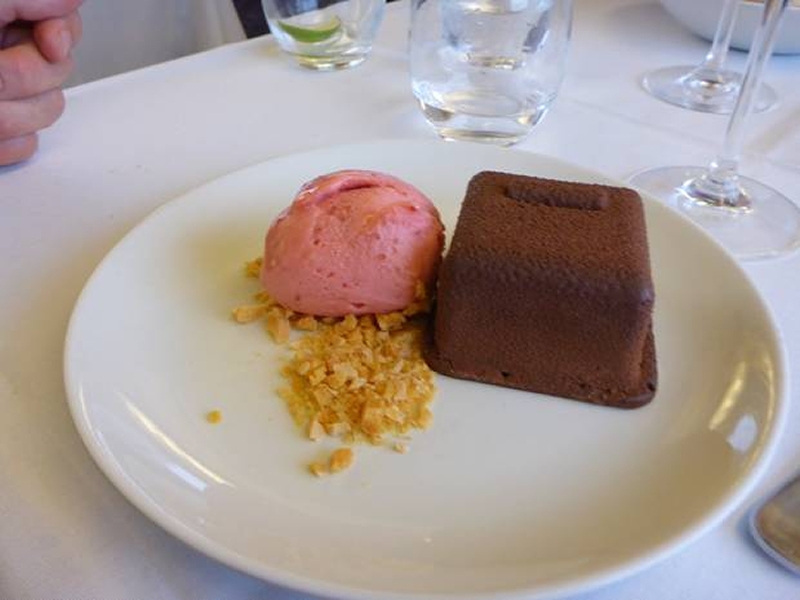
Then after a drink with some new friends we returned to our cabin as the last of the daylight evaporated outside, to find the bunks ready for us and made up with soft white linen.
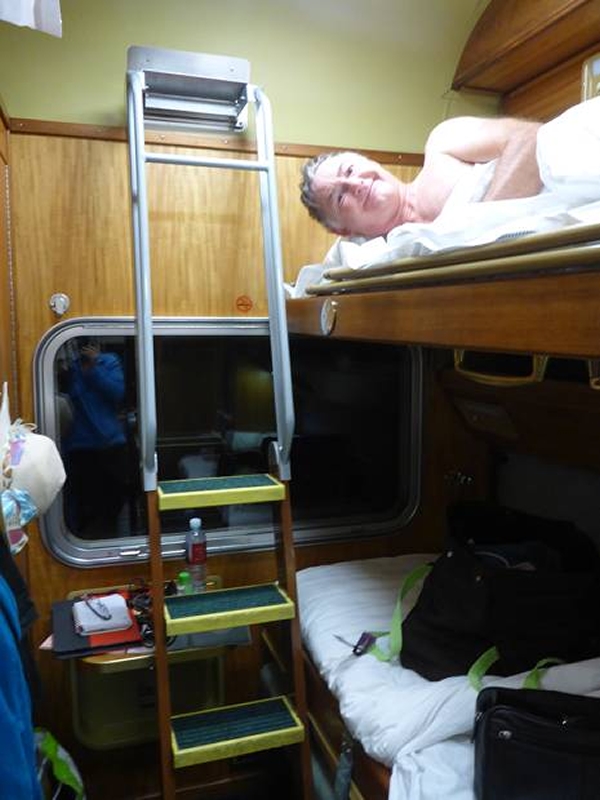
The train was making a rhythmic sideways wobble which was very conducive to sleep so I obliged for a while and awoke as we came to a stop at around 3.45. It seems even the train needed a break and there we rested awaiting the sunrise and our first stepping off point.
Moonshine at Marla
We had covered 1082km from Adelaide and were tapping on the door of the Northern Territory by the time we came to a stop in Marla. Up until 1980 The Ghan train would turn right here and follow the ancient Aboriginal Oodnadatta track eastwards, then to the west and south of the Eyre Lakes to Marree. But now its north all the way to Darwin.
It was still dark but the ink blueness contained a beautiful full moon rising above our silver carriages. Hundreds of little white lanterns had been set by rangers’ hands providing an illuminated pathway for us as we stepped carefully down onto the warm red soil of country, home for eons of the most successful group of humans in history. Two stacks of substantial logs were piled into a burning cones a short distance from wooden tables and benches provided warmth in what our little booklet suggested would be ‘crisp air’. In fact it was already pleasantly warm and warming up as fast our earth moved towards the as yet hidden sun.
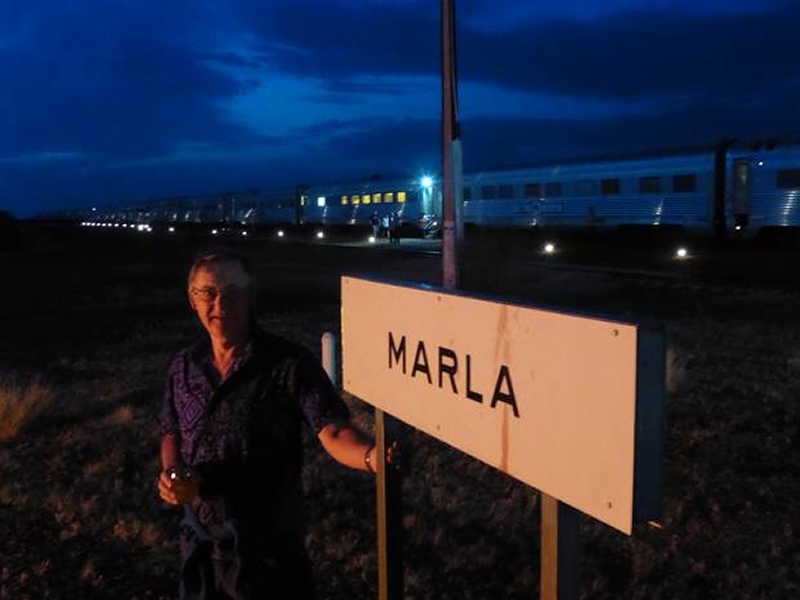
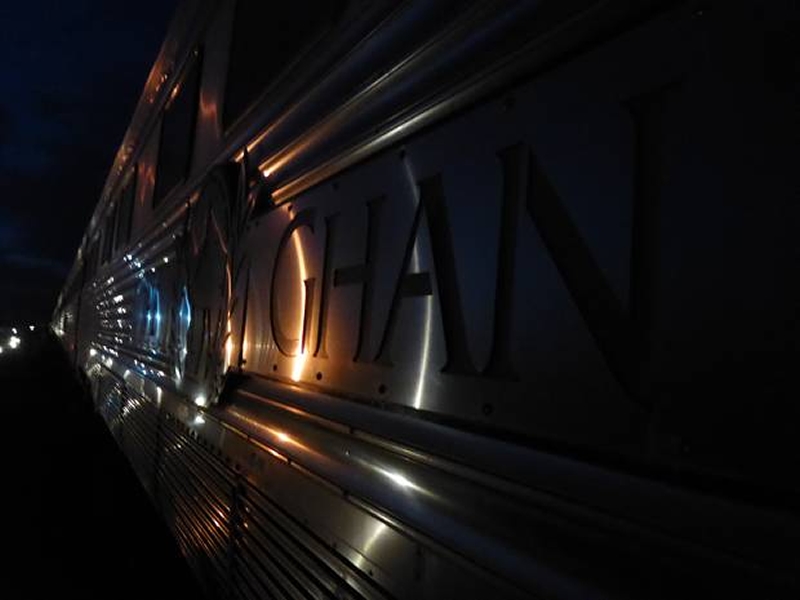
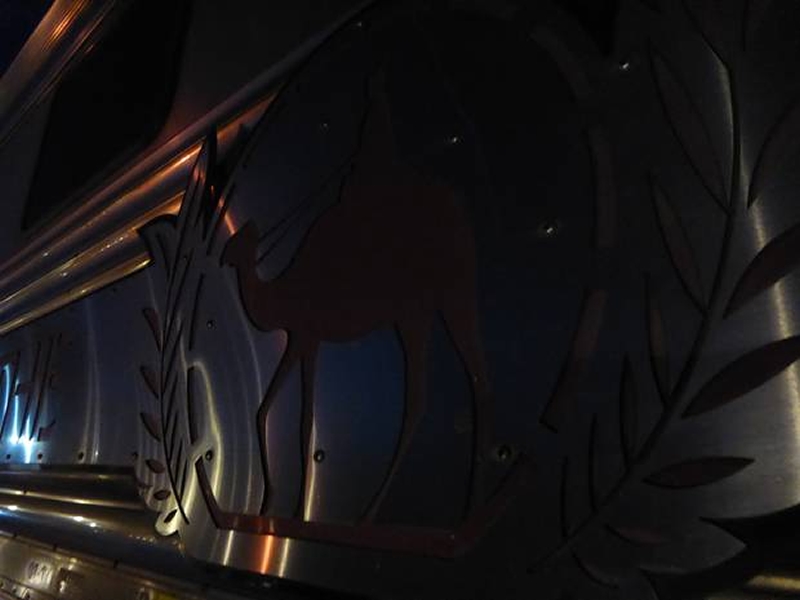
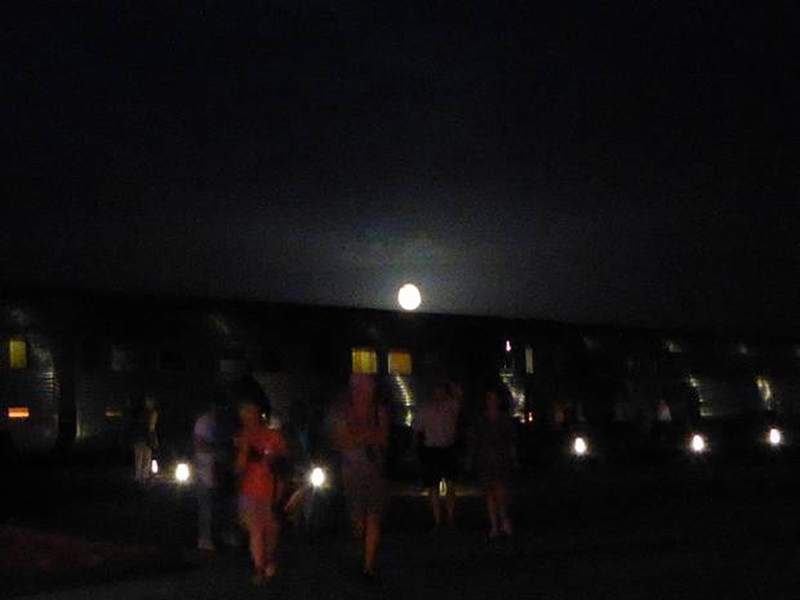
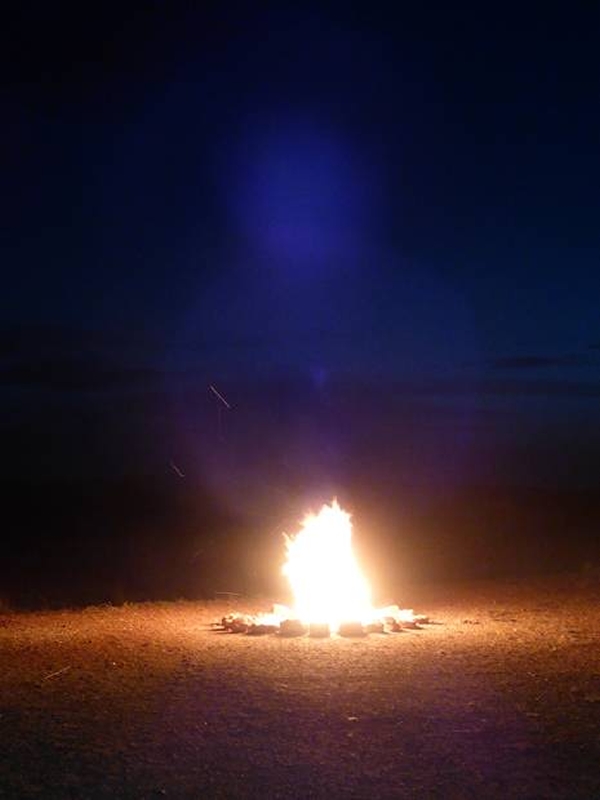
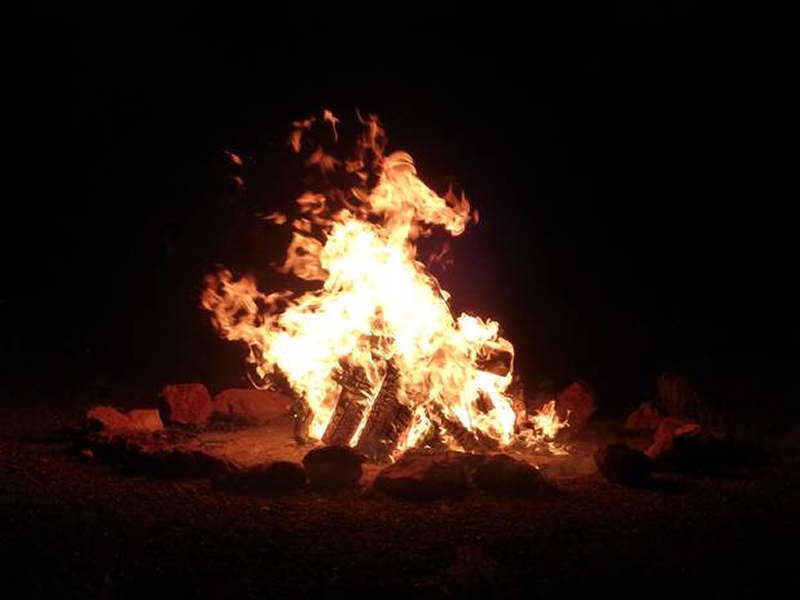
Muted conversations didn’t prevent us from sensing the vast, still quietness of this remote and beautiful spot. Just 100 people live here permanently and we were up and about before almost all of them. A four by four pickup was parked discreetly behind some bushes. I would have liked to chat with the two rangers who had set up the two fires to find out something about life out here.
The smell of cooked bacon joined the woodsmoke fragrance. Bacon butties were being served by Ghan staff carrying trays of the little buns from the kitchens onboard to travellers sitting and standing around in anticipation, their mouths watering. Rob admits to downing three – it could have been more and who’s counting at that hour, “They were only small.”
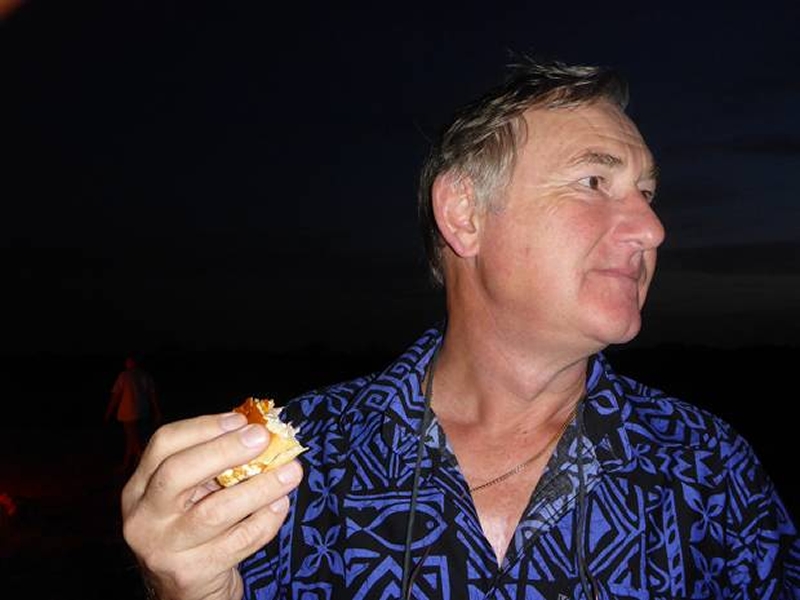
The sun rose behind a veil of thin cloud and a single wallaby overcame its shyness and watched us while passing between the bushes at a safe distance. We drank delicious hot coffee and orange juice while wandering around the area spreading further out as the growing dawn brought the details of the desert to light. Rob posed for me Alan Wicker style between the rails and then with the sun established for the day in its new heaven we wandered slowly back on board ready for the journey on into Australia’s heartland and the Northern Territory border 160km north.
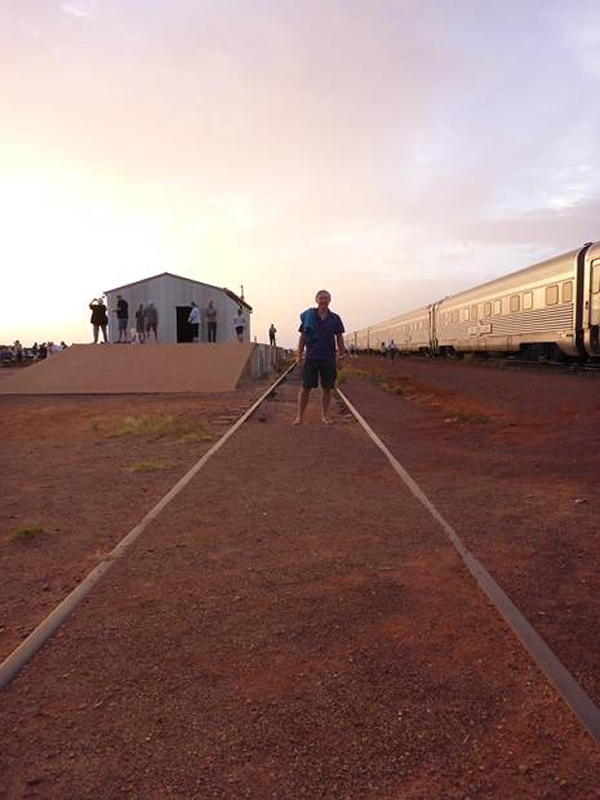
Some of you may remember Alan’s BBC TV series between the 60’s and the 90’s ‘Whicker’s World’. I remember when he was ‘down under’ one shot showed him standing between the rail tracks of I think the Perth to Adelaide train route talking to and facing us viewers as the train approached very slowly behind him. A shot that inspired the travel bug in me.
North to Alice and Waiting to Shoot the Iron Man
Sitting in our cabin as the train moved north we imagined the hubbub of activity that would have been constant when the original wooden sleepers were being laid from Port Augusta to Alice Springs, then known as Stuart, in 1877. Imagine the dust, clatter of construction, voices shouting instructions, hammers on metal, hissing of steam and the animal sounds of recalcitrant beasts all under the relentless blazing sun.
The first camel to arrive in Australia came from Tenerife in the Canary Islands and was called Harry. He touched the earth of his new home in 1839. From the 1840’s thousands of these ships of the desert were imported along with their cameleer riders from not only Afghanistan but all over the Middle East. They were migrants leaving behind their families in search of work overseas and their essential skills were an exact fit for what was needed in the opening up of the biggest country in the world with its harsh climate and terrain. The name ‘Ghan’ is a generic term adopted in due reverence to the essential role these foreign men and their camel teams played.
Through to the early 1900’s they moved food, goods, mail, water, equipment and tools first to the surveyors and builders and then to the remote fledgling towns growing along the rail route. In addition they were vital in transporting the cables, poles, rail and sleepers for the construction of the railway and Overland Telegraph. Indigenous people joined in the effort, learning how to load and ride these novel creatures.
Their broad leathery footpads protected them from the searing uneven ground and prevented them from sinking into the soft sand under the immense weight of their loads and their ability to survive long journeys without water made them highly fit for purpose.
By the time the first section of the line was opened in 1929 their role was being taken over by the train itself which also moved people along with supplies bound for Alice. The route of the Ghan then travelled over some of the most flood prone areas of central Australia via Quorn and Oodnadatta and the wooden sleepers were being eaten to dust by white ants. So the line we were travelling on, that you can see from the plaque, was completed in 1980, used concrete sleepers and followed a different route. I wondered if camels were used once again to transport the equipment and rails and sleepers along this new route. There is a red soil track alongside the line so maybe vehicles were used instead.
Once their role was finished the camels were released and now thrive in country to the extent that many are being transported back to Saudi Arabia to relieve the growing numbers in Aussie. Sadly we didn’t see any and can only imagine that some of the tracks in the sand you see in the photo were made by descendants of the mighty pioneers. Others we could attribute to reptiles like the many species of lizards also feral cattle, horses and dogs, kangaroos and the like.
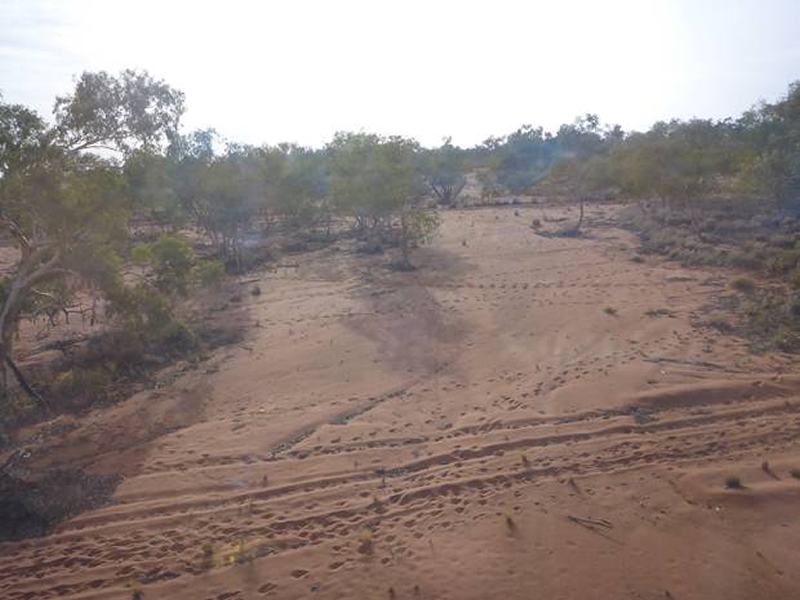
The first trains of course were steam driven and referred to as ‘mixed’ because their cargo could be anything including settler families. One such family had the misfortune of losing their four hens and a rooster who escaped at a remote station. It was a case of all hands to the pumps including those of an academic high flying professor who assisted in recapturing the belligerent birds.
During the 1950’s when the first diesel trains were being trialled to replace steam, one of the new ‘Ghan’ trains became stranded at Finke Station with electrical problems and a blown gasket. The local postmaster, a Mr W R S Hamilton provided the tongue from an old shoe to replace the gasket and the train was soon on its way again.
An announcement came over channel 5 in our cabin to say we were about to pass a significant monument in a few minutes on the right hand side of the train. I went to stand by the corridor window, camera at the ready and set on the Sport Mode as it usually is. Danny our American friend and fellow sailor did the same at the next window. We were expecting a regular big monument and as the train was by now moving at a good pace I wondered just how likely it was that we would see it at all as we whizzed past.
I craned my head to see, “It’s coming” I warned Danny. ‘Click’ and it was gone. Was that it I wondered, “Say did you see it? I didn’t,” Danny queried. Did I manage to catch it in the semi second in which it appeared? A quick look and what you see is what I got. ‘The Iron Man’ as it is called measures 1 metre in height and was built by railway workers to commemorate the one millionth concrete sleeper laid on the new stretch of railway between Tarcoola, where we turned north and Alice Springs.
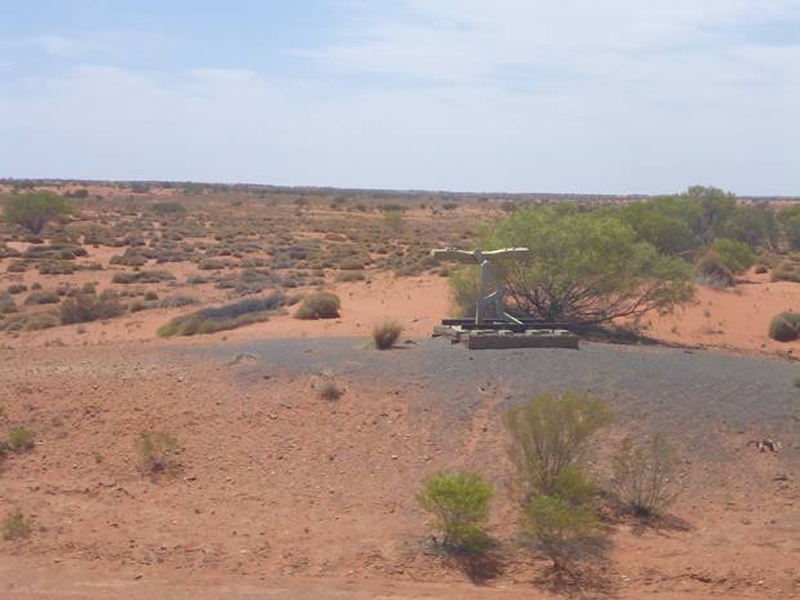
It may sound unlikely but there really was something new and wonderful or maybe tragic to see everytime we looked out of the window. Since the trip we have learned that the extreme heat wave being experienced in this part of Australia was drying up what have always been permanent waterholes, billabongs at which the wild animals have always been able to drink. Locals found over a hundred dead horses around one and of course there will be many other such incidents that have not been seen. I counted five cattle carcasses near the track, so you can imagine there are many more out there, out of sight.
Beautiful cirrus clouds shooting upwards across a blue sky and circular soft grey spinifex ‘nests’ amidst neat little trees on a warm ochre ground reminded me of yellow flowering fields of rape against a cloudless blue sky on an English summer day with maybe a single green leafed tree for dramatic effect.

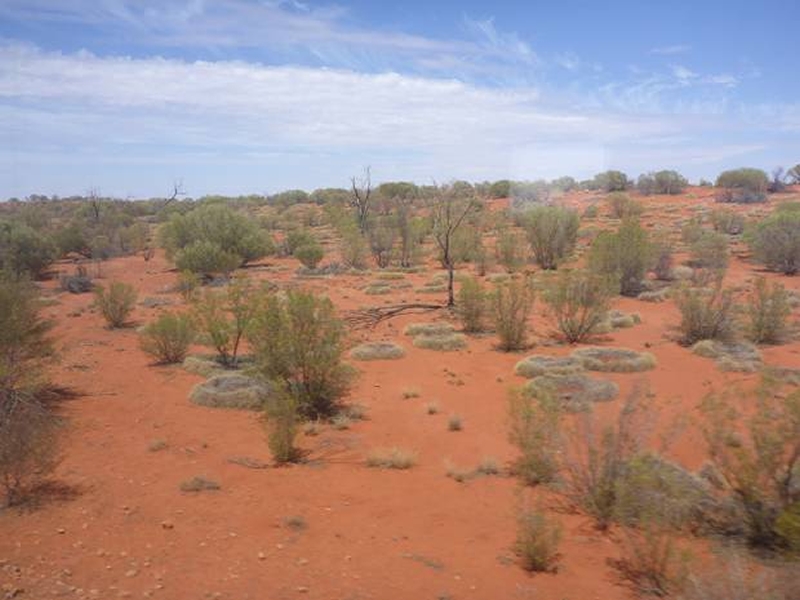
We lunched with Joan and her granddaughter Emily from Melbourne. They were a happy team, Emily gently bossing ‘gran’ around and gran taking little notice. Emily drives buses for a living; passengers would be wise not to mess with her.
All along the sides of the track were areas where the soil had been scooped out and used to raise the track level. These dry, cracked ‘pools’ obviously filled with rain water occasionally and we imagined the animals and birds that would crouch around the edges for a welcome drink.
Another announcement suggested we look out for the dry river bed of the ancient Finke River you see in the photo. I am always a little dubious about claims that something is the ‘oldest’ or ‘biggest’ or ‘only’ one in the world so I will just say that the rock formations in the riverbed of the Finke date back 300 million years, now that is old!
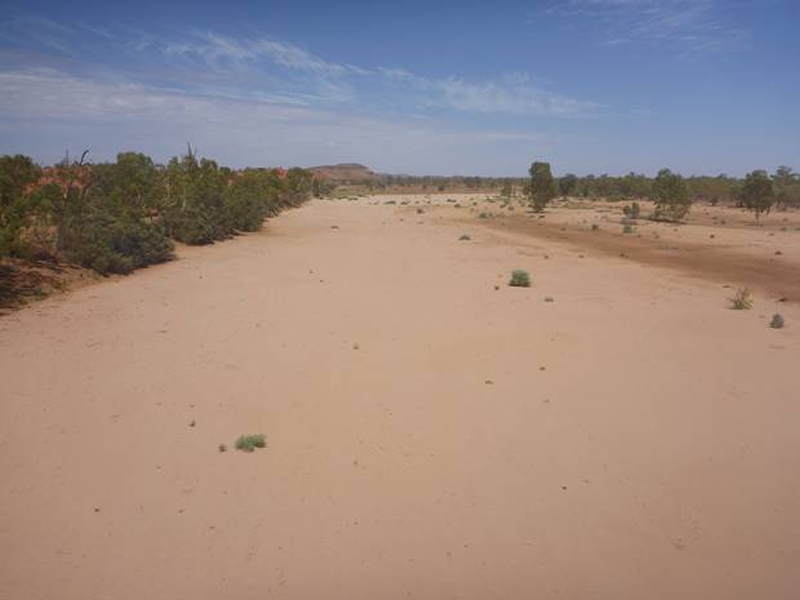
Leaning fence posts, cattle grids, herding pens and random, healthy looking cattle were the first hints that we were approaching civilisation. On the outskirts of Alice having trundled through a gap in the MacDonnell mountain range we motored very slowly over a few level crossings where the poor motorists must have to wait for twenty minutes or so as we snake by, passing the time perhaps enjoying a snack, playing games or chatting on their phones or boxing clever and noting the time so they could avoid the wait in future.
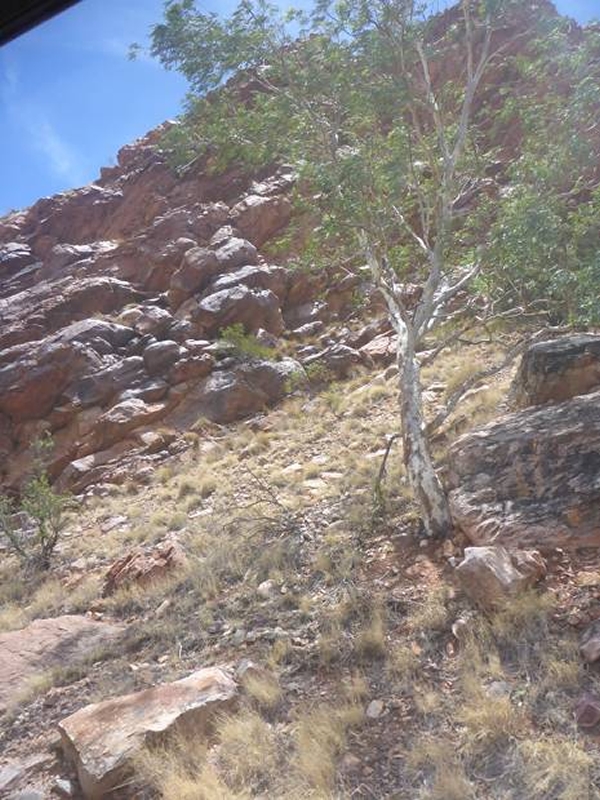
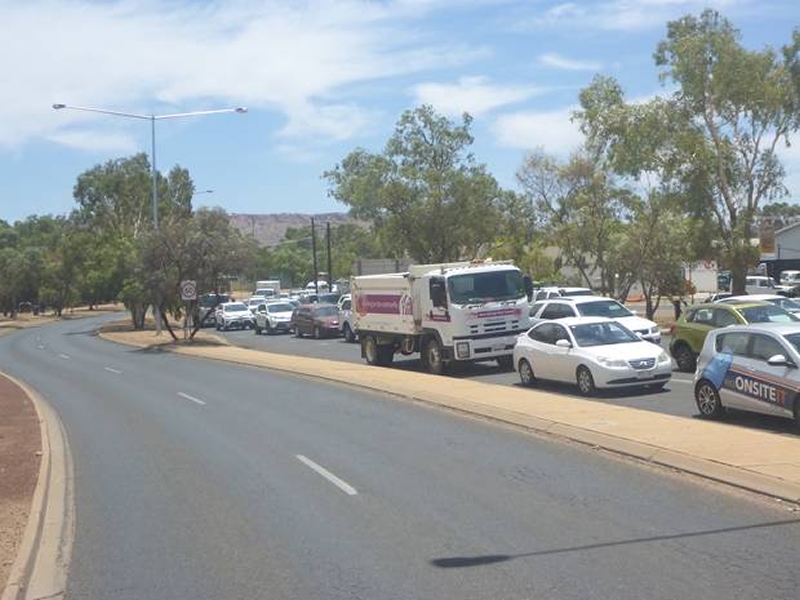
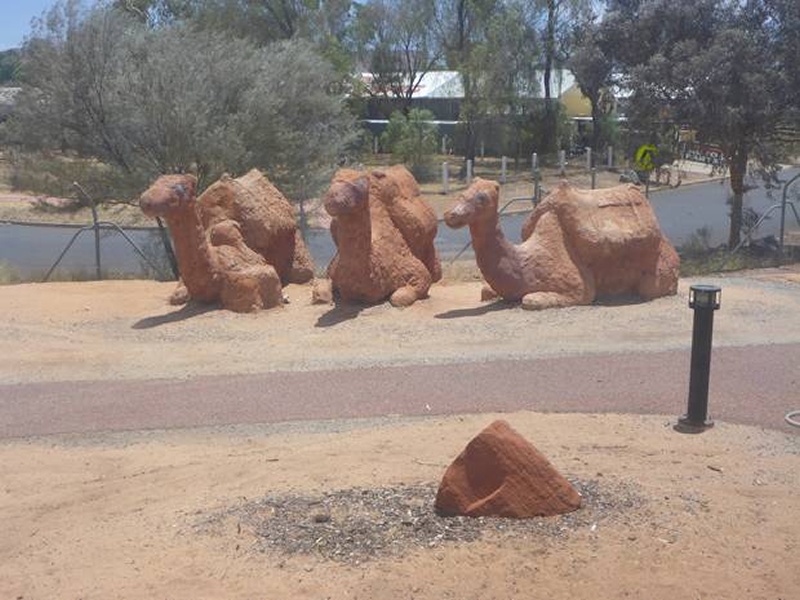
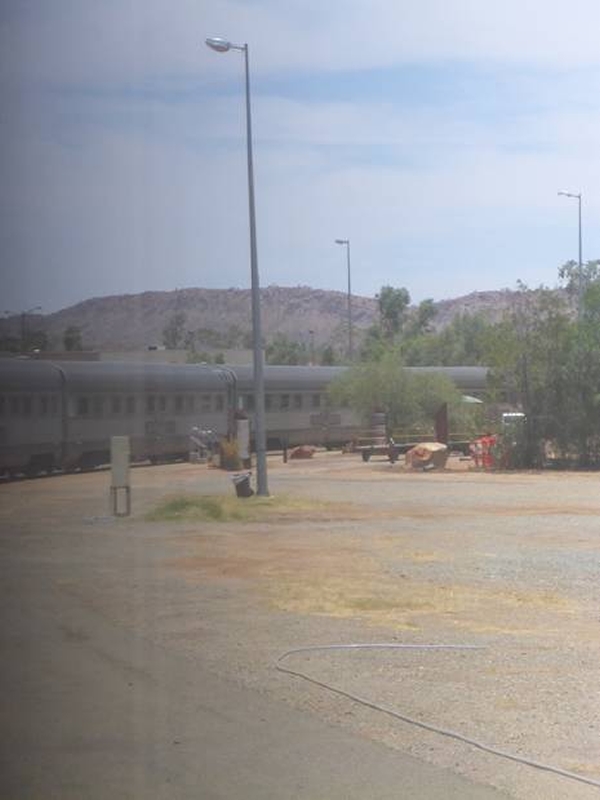
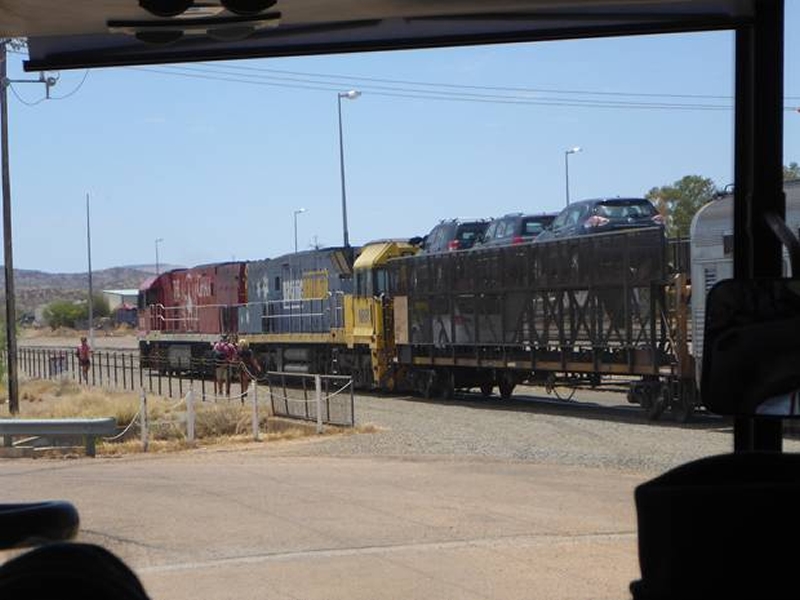
An Eagle steals the Show and Don’t Tell Prince Charles
We all sat in the amphi-theatre shaded from the sun awaiting the start of the desert bird show. The Park brings together some of the many species that live in the vast red centre of Australia that otherwise we could only imagine live there. It is an environmental and educational facility which both enlightens the likes of us and carries out research projects to better understand the nature of the central desert. It covers 3212 acres and over 100,000 people visit each year.
The temperature had just topped 45’ and I was gently fanning myself when a movement above the MacDonnell mountain range that provides a backdrop to the park drew my eyes upwards. By the time the young lady came out with her, familiar to us, barn owl most of us were taking glances away from our host. “What are you looking at?” She queried. Eagles soared majestically over the heights giving her a welcome distraction to tell us about because the show had been drastically cut short as it was just too hot for the other birds to make an appearance. A heat stressed desert bird remains still and hidden to retain moisture and energy. But the pretty little barn owl was willing to perform.

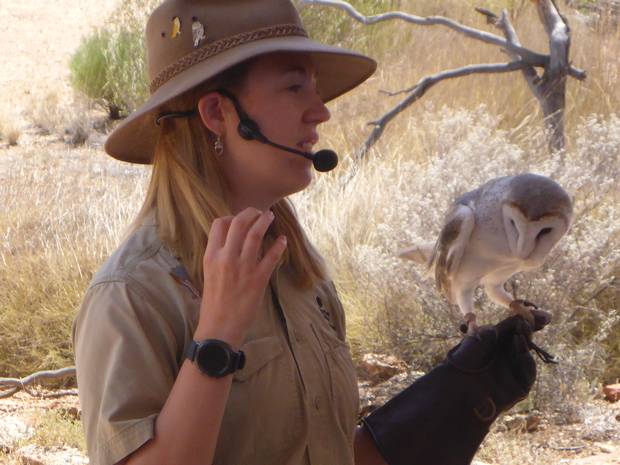
It is members of the Arrernte Clan that run the park and we spent time with both a guide and the director from the clan while we were there. Taking the short distance from the open air theatre to the nocturnal house was a genuine walk in the baking red centre of country as the site is an area of outback fenced off and changed only by the addition of a few buildings.
Dingoes lie in and under the shade of a hollow log, a bustard looks agog at us and an emu struts across its little pen. All the while the guide talks about the things we are looking at but the group is spreading out, some folk heading quickly towards the cool dark of the nocturnal building miss out on what is being said. The heat is becoming something of a distraction.
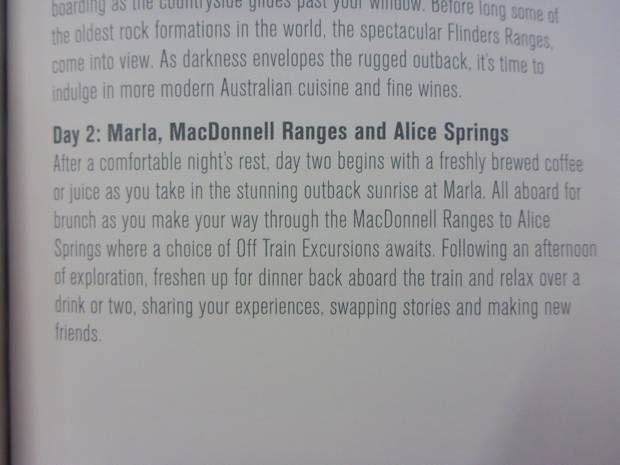
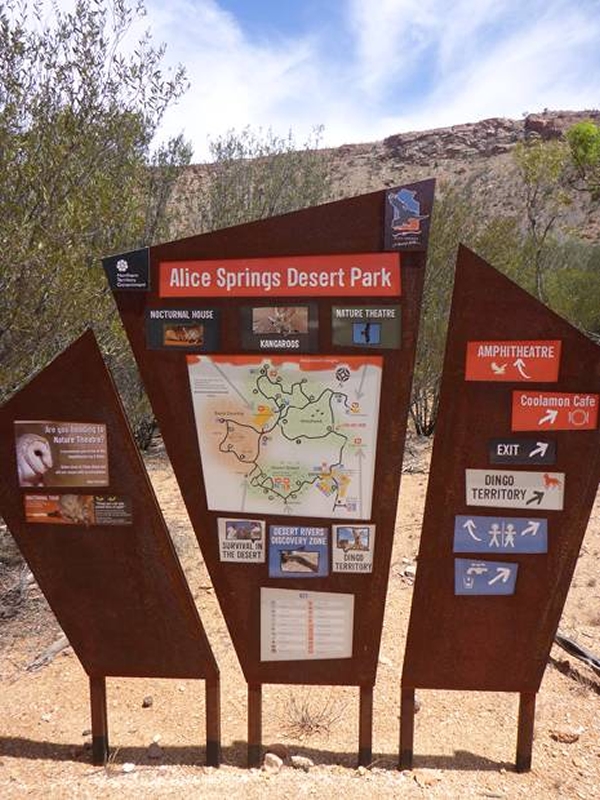
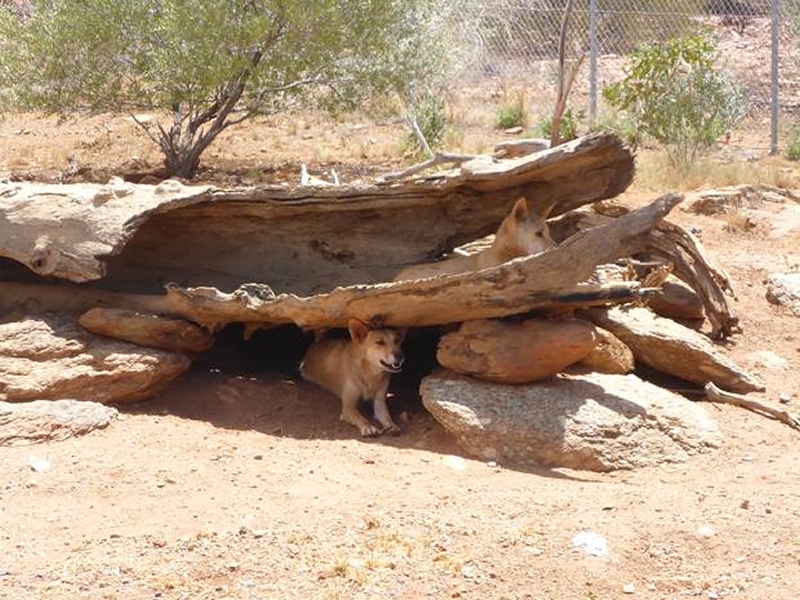
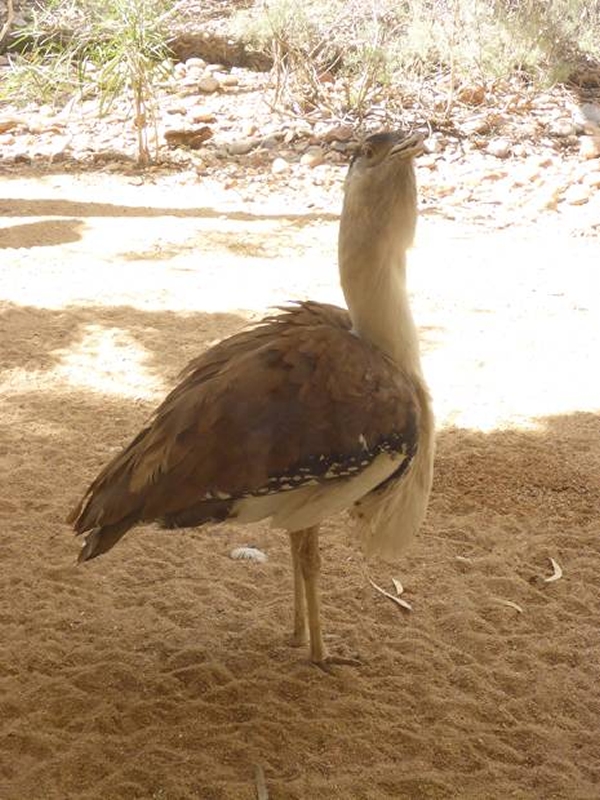
This excursion has been a second choice for us as the Simpson Gap walk was cancelled due to the heat. Others in our train group, including the physically less able, have gone off for helicopter and fixed wing aircraft scenic flights and camel rides and others have left for Uluru Rock. Its masterful organisation on The Ghan Trains.
See the beautiful green lizard camouflaged on its tree trunk and there were fish in a tank that come from the part of the Finke River we crossed, but where there is permanent water above ground. Thinking their existence must be safe from threat out there in the wilderness would be wrong. Backpackers and campers who wash themselves, their dishes and their clothes in the river water are polluting it with chemicals. When we were on the Machu Picchu trek we were only allowed to use chemical free soap; a little more education needed there.
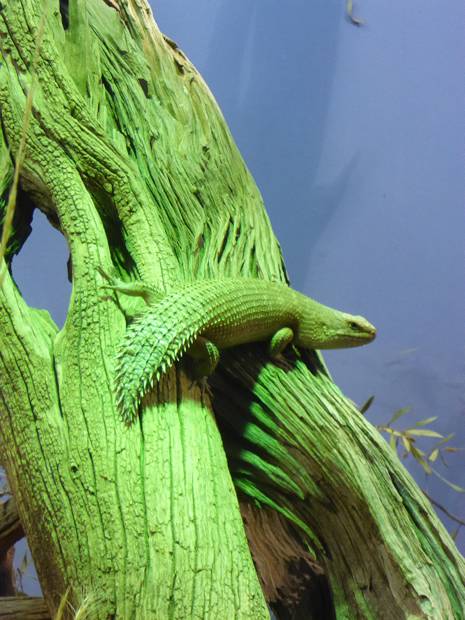
I have had to settle for two poor photos of pictures of the pretty little Mata and Bilby as they were hidden away in their mini deserts. We lingered in the nocturnal house before venturing through an aviary of colourful desert birds until we saw a familiar black and white stilt identical to the many that thrive on the shores of the river at Whangarei. We were on our way to the lecture hall where we first saw a film of the natural desert world on a wide screen. Once it was over the screen descended to reveal a vast glass area looking directly up to the MacDonnells.
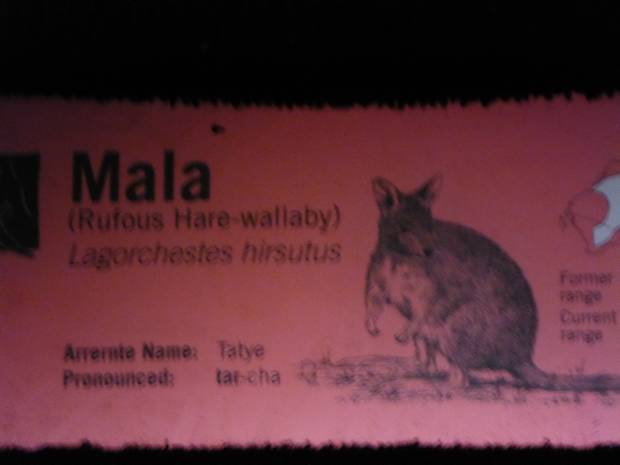
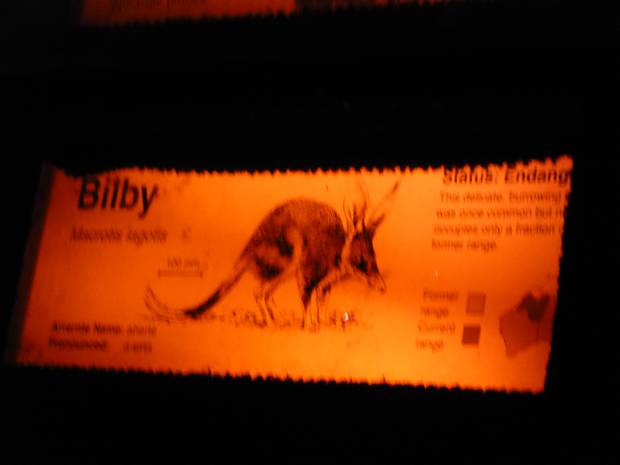
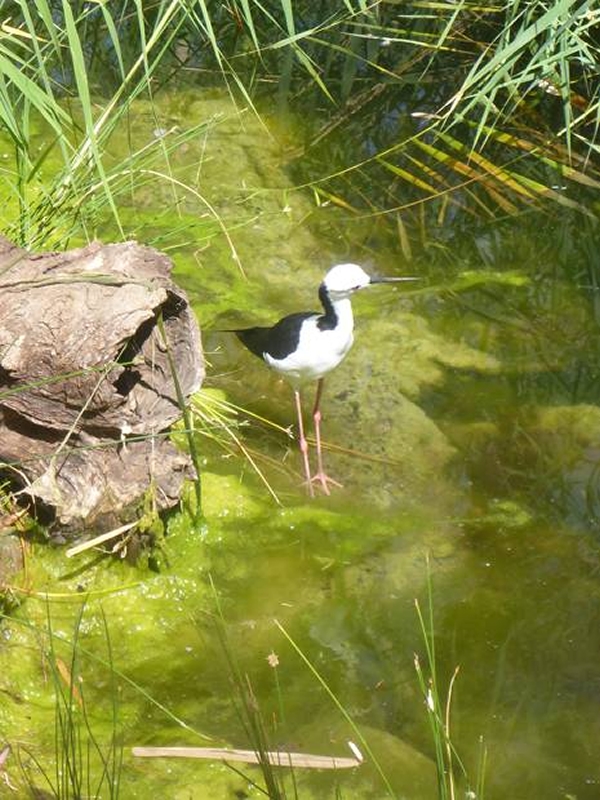
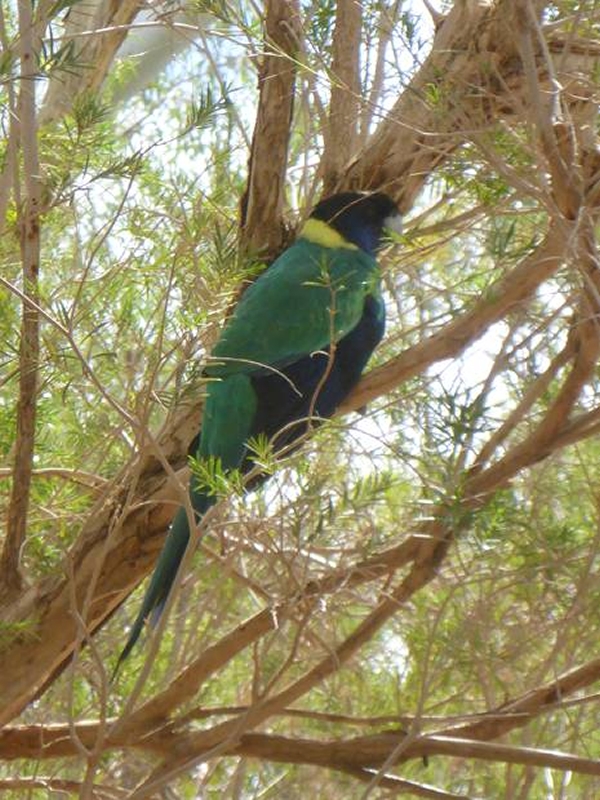
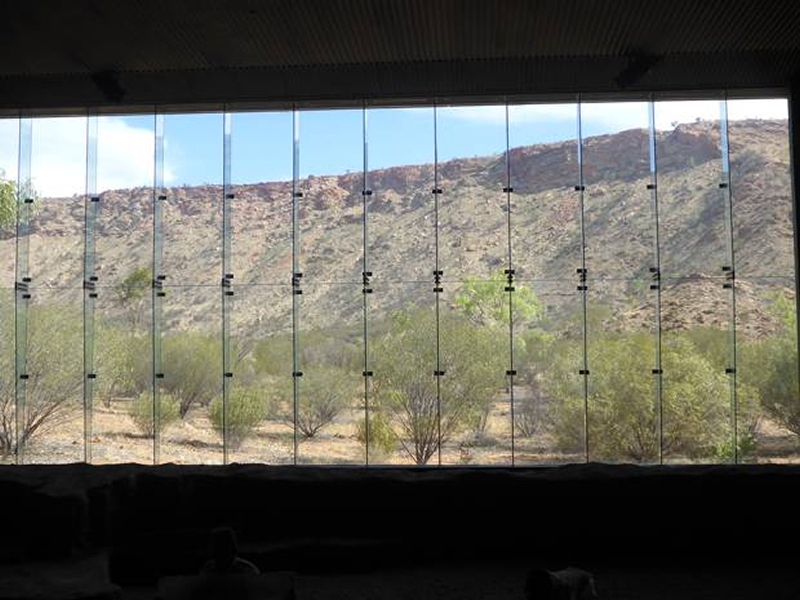

To fill in our time where our visit had been otherwise shortened by the excessive heat we were then fortunate in having an elder of the Arrernte people and the Director of the park give us a talk about the ancient marriage laws that Aborigines have practiced for tens of thousands of years to prevent inbreeding. When the Prince of Wales visited he was advised not to give this particular talk to the Prince, maybe as it correctly contradicts Queen Victoria’s thinking that combining royal the families of Europe through marriage was a good idea or more possibly in view of the behind the scenes activities of the modern royals!

Our host laid down his map and held up a yellow card upon which were two outlined black squares drawn at right angles to eachother, so there were eight available points. If more than eight clans lived close to eachother then more squares could be added to the diagram providing more points. Each clan had its own point so young couples were picked from different points, in other words a different clan. They had slightly different skin colours which were given names, so this method is called selection by skin names.
Their childrens’ partners were then chosen from other points in an ordered rotation. This makes our methods look quite random but looking back in English history one can see a kind of ‘system’ when young people from different villages looked for partners at dances held regularly in village halls.
Marriage alliances across clans were often made when clans met together in gatherings like the one in the painting I included on our South Australia Gallery visit in Adelaide and they helped solve disputes that might otherwise result in warfare.
Our coach driver on the way back to the train talked of how valued the Aborigines have always been as part of the labour force through the opening up of outback country to the present day. He pointed out a school where all the children learn two Aboriginal languages before they learn English as a second language so they can live in both worlds.
Back in time it was thought disrespectful to speak the language of a different clan directly to them. So elected members would go to a different clan and learn their language and then go back to their own clan and teach it. They were multi-lingual for reference purposes only and not communication. This way languages are preserved.
Back on board our train we spoke just one language after a hot day in the desert, “See you in the bar shortly!”
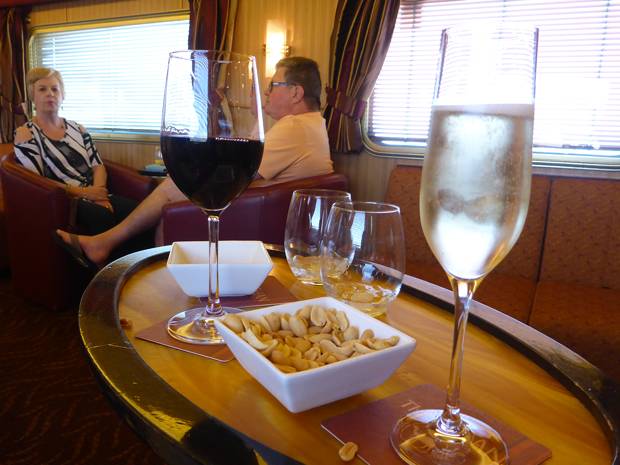
Snakes and Ladders and Katherine Calling
Our second night on The Ghan travelling north to Darwin from Alice (re-named from Stuart to Alice after Alice Todd, wife of Charles Todd who was head surveyor and orchestrator in the building of the Adelaide to Darwin Telegraph Station in Alice Springs that ran from 1871 to 1932) towards Katherine took us along the newest 1420km section of the crossing from Adelaide to Darwin which was completed in record time opening in 2004 and finally linked the two cities opposite eachother on the north and south coasts of Australia. A country divided by a railway line.
The full moon arced over us in the night sky, a heavenly headlight sending a shining silver line down the back of our wheeled snake as it sped more quietly on its new tracks through changing countryside. I lay in bed watching the semi blurred scenery passing by. Gone was the hot red centre and the nests of spinifex, gone were the views of the distant hills. Instead the sun of the new day painted a pale lilac glow through a woodland of trees that were charred up the lower trunk after a cool burn, designed to keep the undergrowth low and thin and prevent the risk of all engulfing fires.
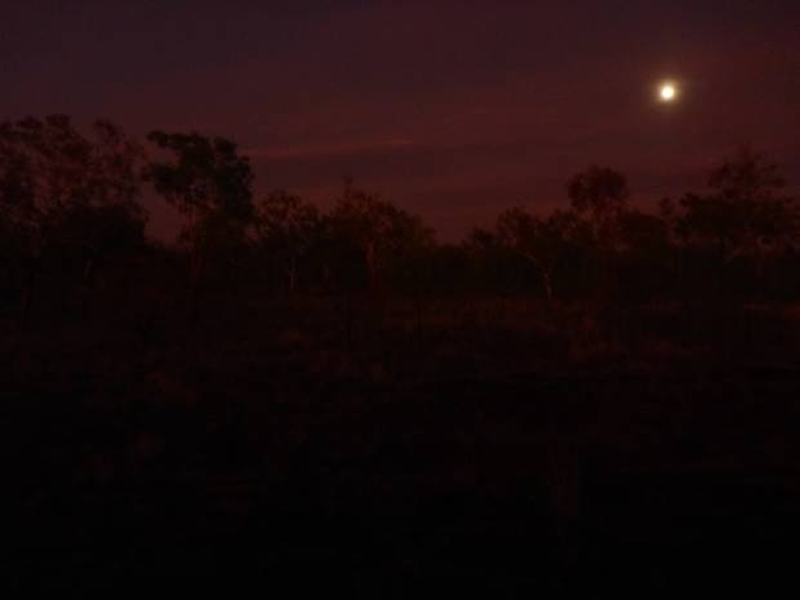
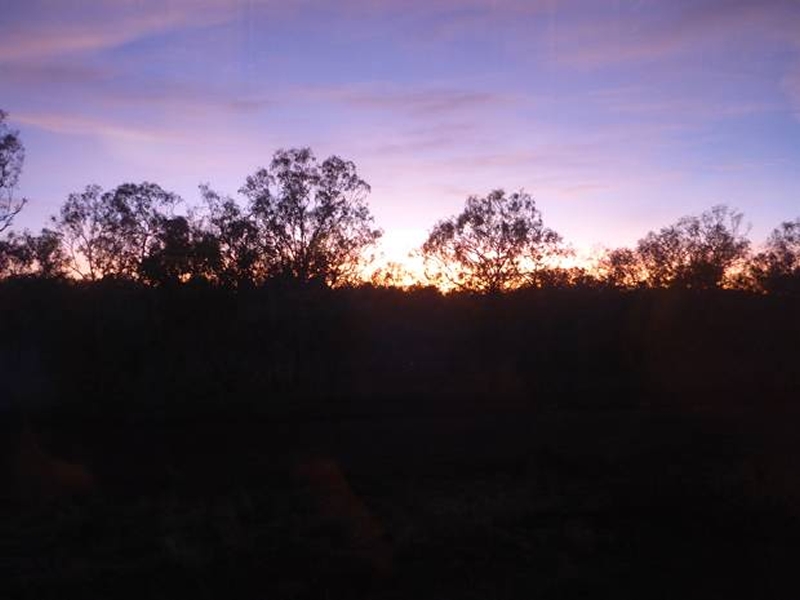
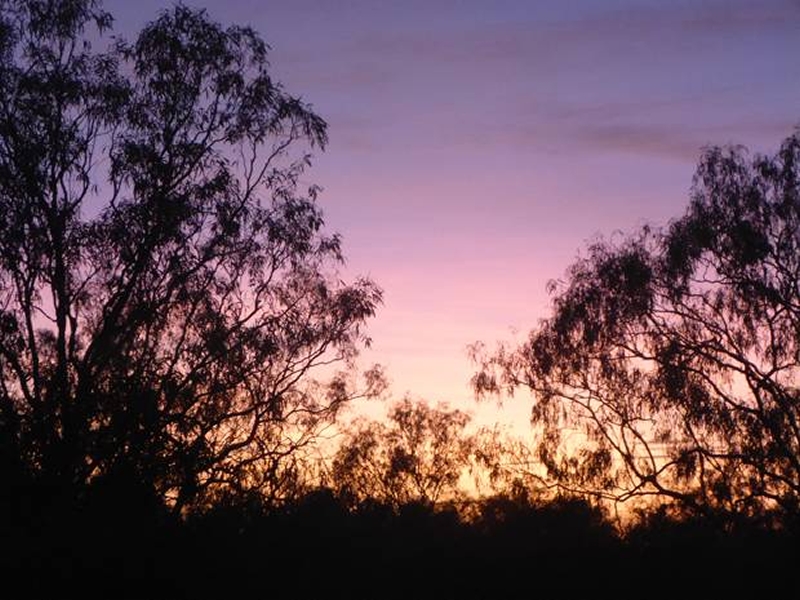
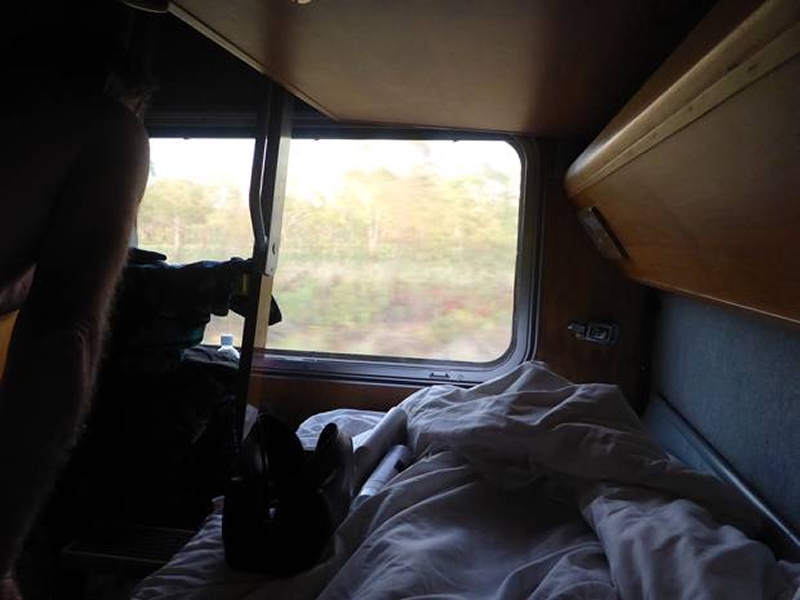
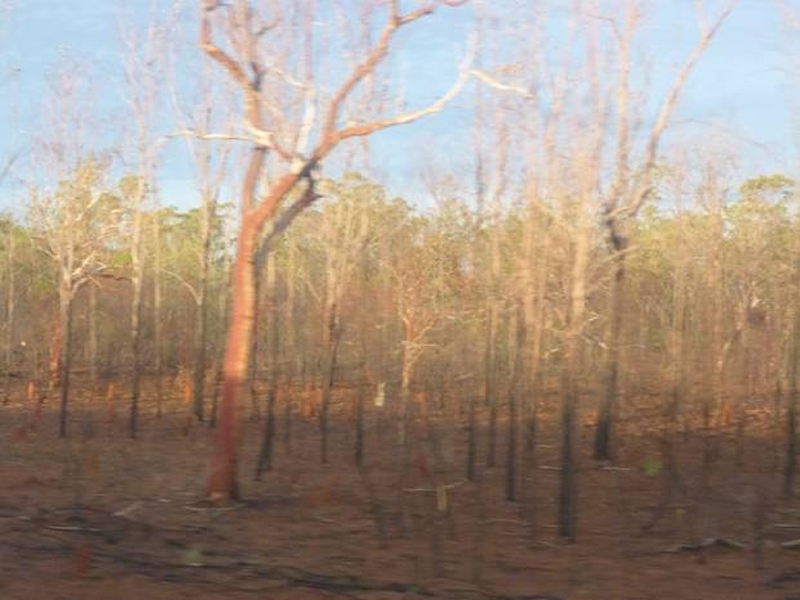
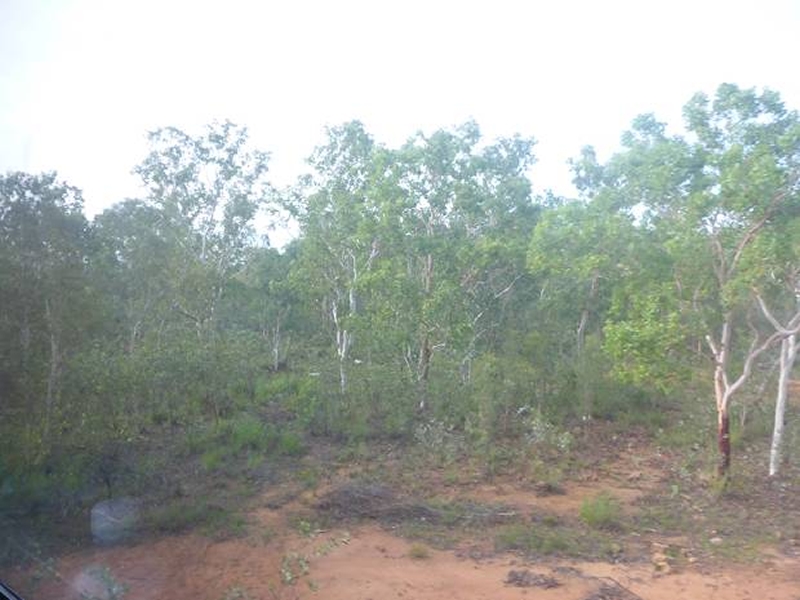

Then into the tropical climate of the top Northern territory and luxuriant green woodland all around. This area is fed annually by the generous monsoon which raises water levels in the rivers by five metres in places and fills the frequent scooped out pools at the side of the track with water. These ‘scoops’ are where earth was dug out and used to make the base of the railway line. To travel on the Ghan at the height of the monsoon and see birds and wildlife around them taking a drink must be a lovely sight. We were travelling at the anticipated start of the monsoon.
Humanlike forms, hunched head and shoulders and bodies swathed in cloaks of ochre look as if they’re doomed to wander the forest forever, solitary and moronic. The biggest of the hundreds we viewed from the carriage window have unwittingly become partners to the aborigines in their burial practices. The termites that built the ochre mounds and now live in them also dine on the sweet centre of the tree trunks and aborigines use these hollowed out trunks or moriety as they are called. Their artists paint beautiful dot and swirl pictures on them, doubtless telling a story about the deceased in their designs. After a corpse has decomposed in the ground the bones are retrieved and placed in the wooden tubes. Then the top is knocked off a big, derelict mound and the tubes are respectfully placed upright in the mound. Finally stones are used as a lid to prevent animals breaking in to the vertical grave. Remember the ones we have seen in the museum in Adelaide.
Rob awoke and climbed down his ladder to have a look outside with me. Two beautiful sand coloured Brahman Cattle with their floppy ears and humped necks stared at us as we passed. We sensed our amazing trip was coming to an end and we’d do it all again just so we could see those earthy scoops full with rainwater, walk through the Simpson Gap to get a sense of country geology, and ride on a camel as a reminder of the essential work done by these princely ships of the desert and maybe take a fixed wing plane flight over the MacDonnell Range to see the bigger picture.
Instead our final expedition from the Ghan was to the Katherine River Billabong for a boat ride guided by Jamey, a member of the Jawoyn Clan and accompanied by a ‘nuisance’ of what looked like small houseflies intent upon obtaining a drink from any available orifice on our bodies especially the eyes.
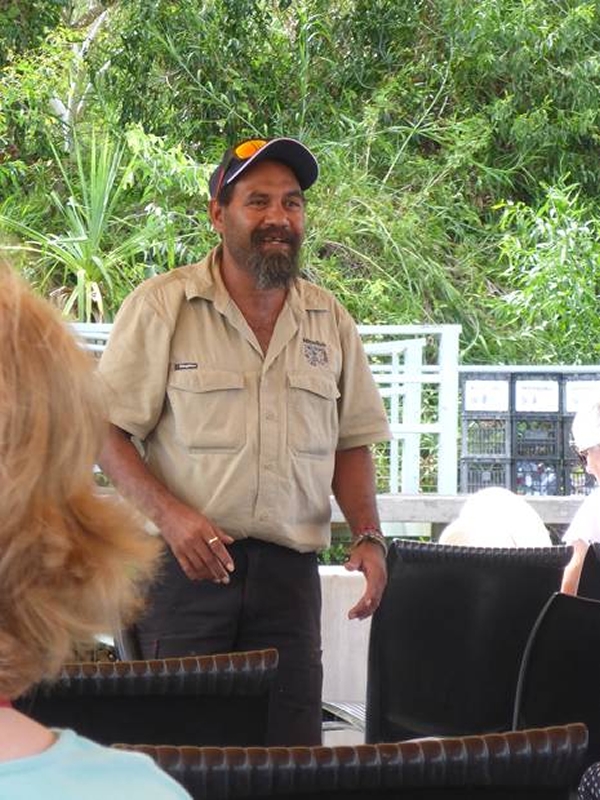
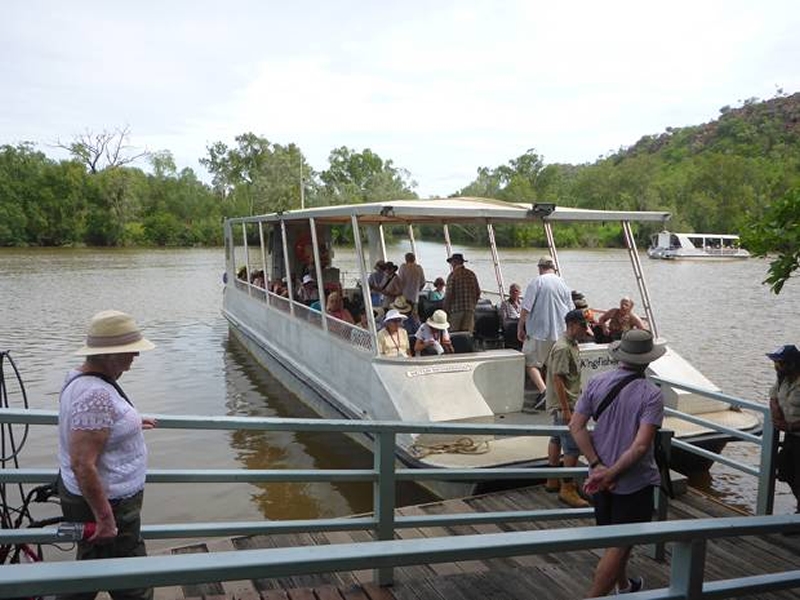
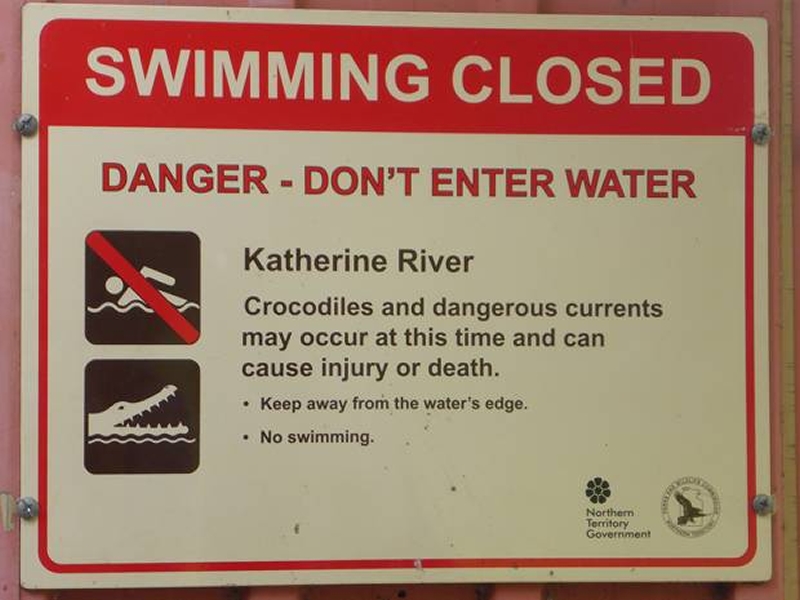
Jamey of the Jawoyn People
With his raggedy beard and toothy grin and twinkling eyes I could tell Jamey was going to give us rail travellers a good time.
Sitting aboard the flat bottomed aluminium river boat, warming up after the chilly coach ride, it wasn’t long before Jamey, who had the rare skill of finding that common ground with strangers upon which a fun and meaningful relationship develops in seconds, started telling us about the history of the park and its people.
Since arriving in Aussie I have started to use the video facility on my little camera. Not that I can use it in the blog, which is why I haven’t used it much before but more so I can show family, especially grandchildren things about this big country like the animals and unusual things we have done and of course the Ghan trip.
So I was playing this cruise back to Henry and Ruby and what came over was not just Jamie’s friendly story telling but the warmth and humour we all enjoyed with him. “Not much has changed with the way of life here, apart from woman foraging in Woollies with a trolley for roots, fruit and all that sort of stuff!” (Aussie Woolworths is a big national supermarket)
He explained the struggle they have had to retain custody of their homeland after losing it to the federal government in the sixties. How they fought and eventually won title back only to have to lease it to the government again so they could run the park on it. Heard the same in Canberra with Tyrone, remember.
Even when Jamey described the arrival of the missionaries who with their callous zeal stole a generation of young aborigines to bring them up the white way at mission stations and then putting them out to work “for low wages, well actually none at all…” there was no malice or anger in his tone. He said himself that they did not hold grudges over the disruption caused by white man.
He explained their creation story, we know as the dreamtime, where everything around them was in spirit form and all they knew and know came from the spirits of the past. How their ceremonies are held to appease the spirits who taught them everything including what plants and animals they can eat including “the big ugly ‘file’ (it sounded like) river snake but he’s quite tasty and even croc is on the menu.” They taught them marriage laws to prevent marriages within clans “that would become a bit dodgy…”
Jamey showed how the river level is lower than is normal at this time of year because the tropical monsoon is late in coming, we had that to look forward to on our second day in Darwin. But the river level was high enough to submerge the jetty that is used in the dry season, so we moored where the front ramp of the craft could be lowered onto a level rocky surface.
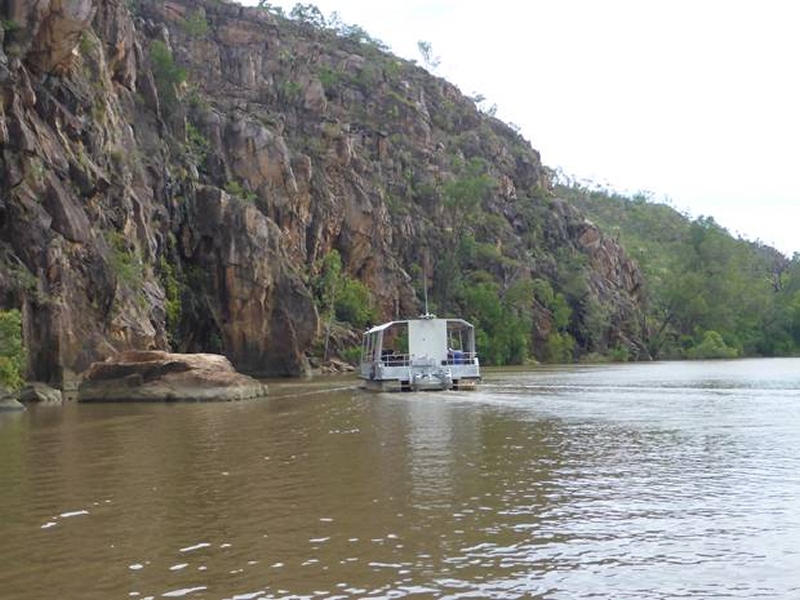
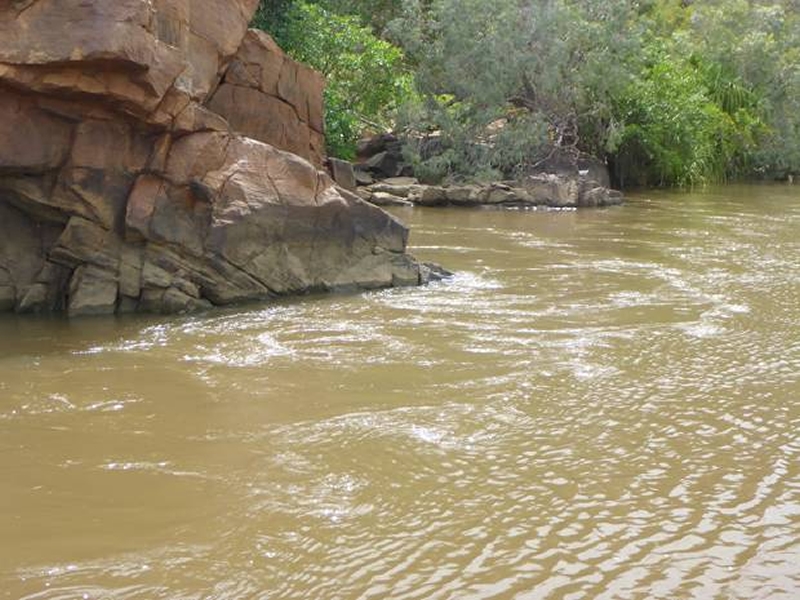

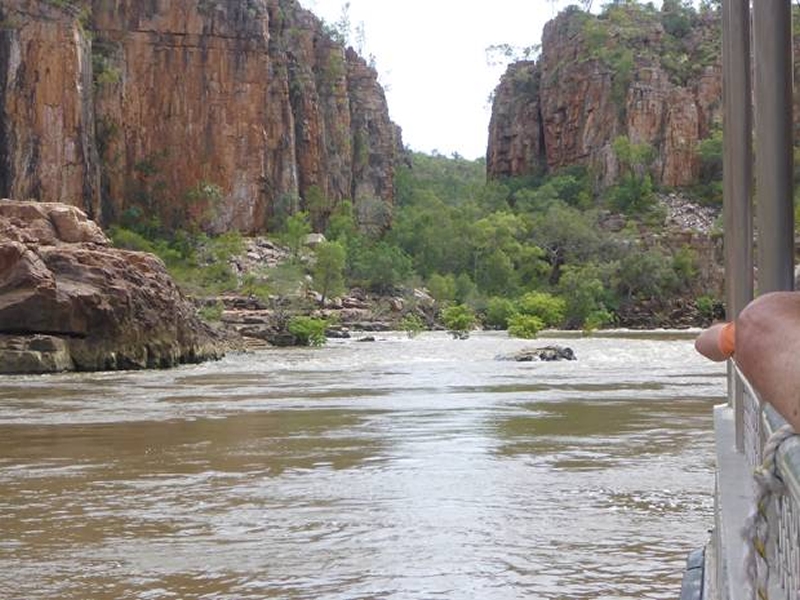
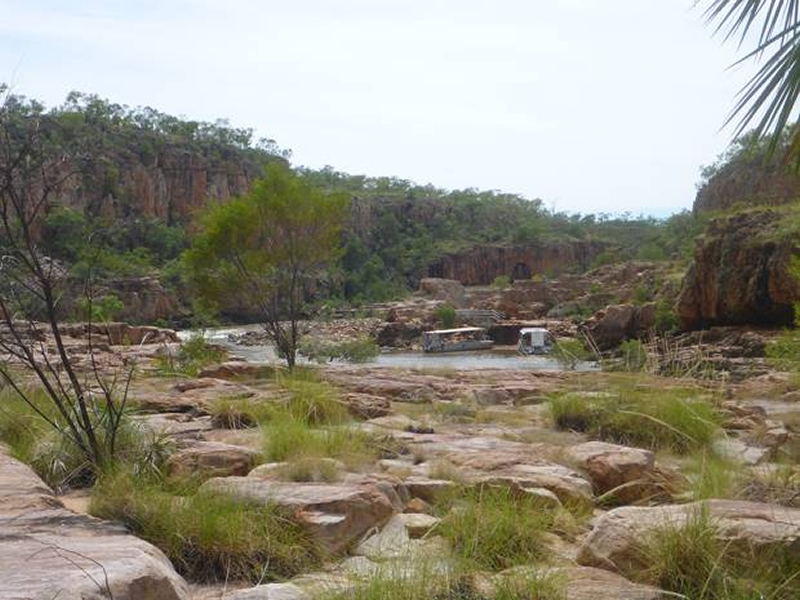
Our guide book said we had to be fit enough to embark and leave our craft and one lady struggled and was then given lots of help to make it to the paintings. Hats off to her and the guides. The support my foot had from my laced up walking shoes meant I was able to do the walk with little discomfort.
Our muddy river journey through the bendy first and second gorges of the Nitmiluk Gorge revealed towering sandstone cliffs of warm ancient rock which have for over 60,000 years provided a tabula rasa of rock faces, a blank hard canvas ready for the artistic hands of the male indigenous creators.
After a rocky scramble the short distance to the gallery we would explore, Jamey explained the practice of an adult spraying an earth based paint from their mouths over the hands of a child so their past and future would be preserved. The depiction of the powerful serpent and what looked like the tentacles of a jelly fish but is in fact the roots of an edible waterlily. “Still today 20% of our food we collect from the country, 40% we forage from shops and the rest, well on Fridays that’s a takeaway!”
Rainwater can stain the rock a dark charcoal colour and damage the paintings so silicone has been applied to the rock in long strands above the paintings to deflect water. Underneath we saw beautifully preserved images of turtles, men hunting, women with their woven bags and a kangaroo complete with a joey in her pouch painted by ancestors of the Jawoyn people while other parts of the world froze during the Ice Age. Such a powerful pictorial link with the past took me right away from where I stood to the sights and sounds of families through millennia living a lifestyle that barely changed for so long, until something bit me on the leg and brought me whizzing back through my time warp to see what looked like a pale yellow dung fly having lunch on me.
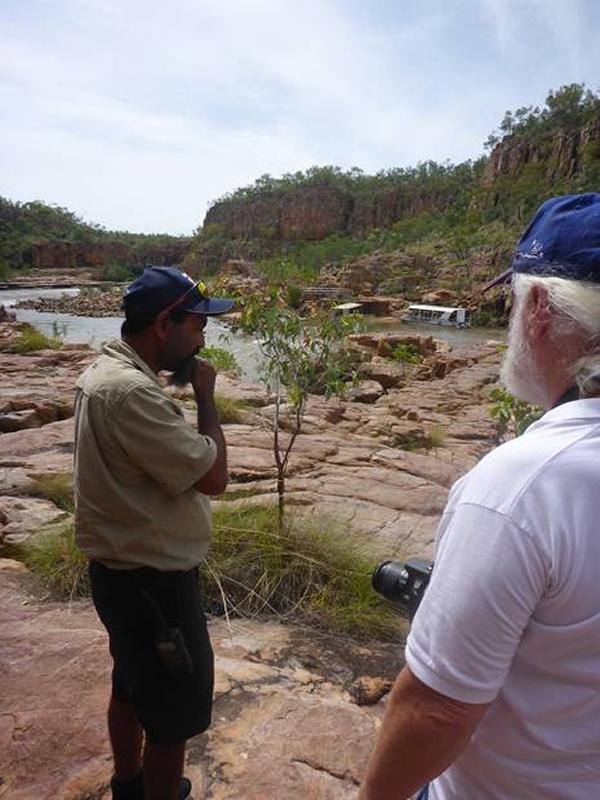
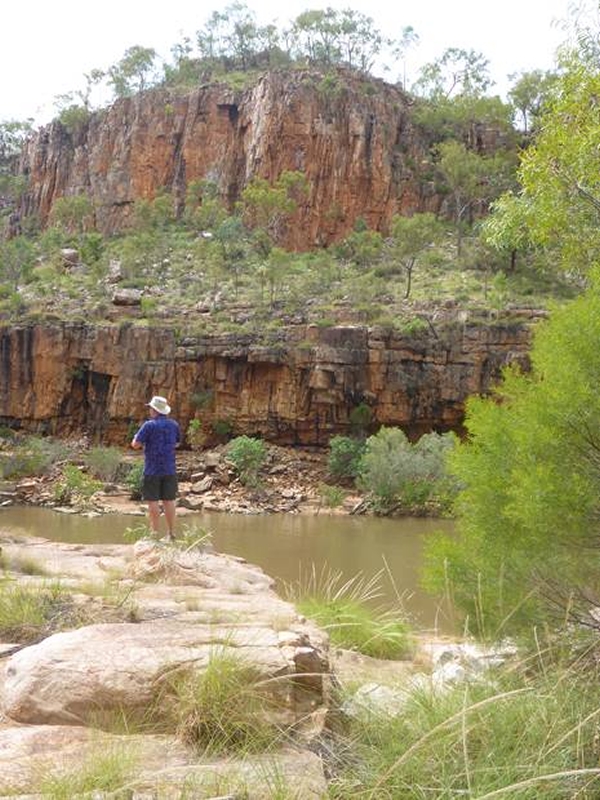
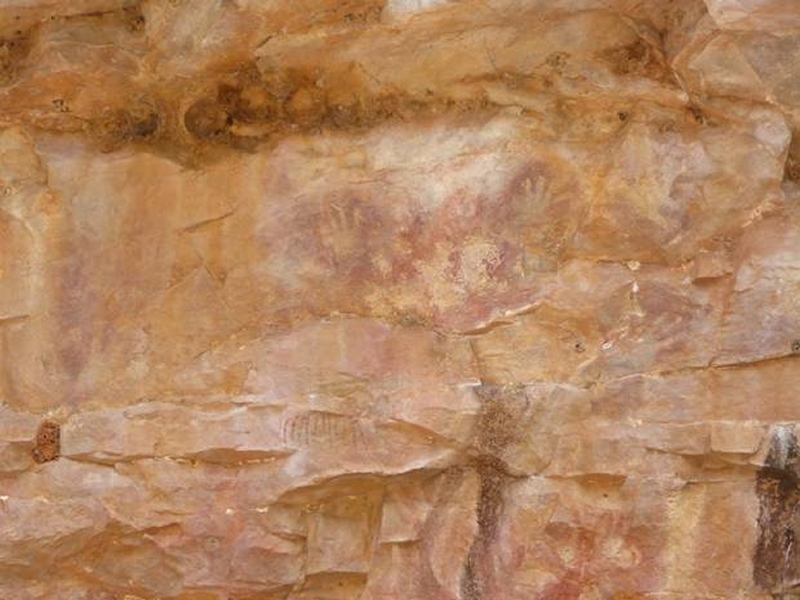
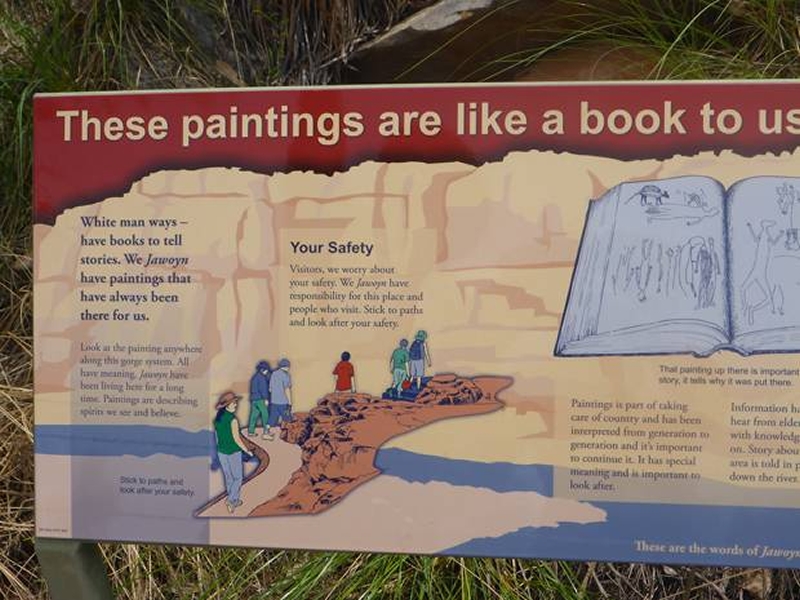
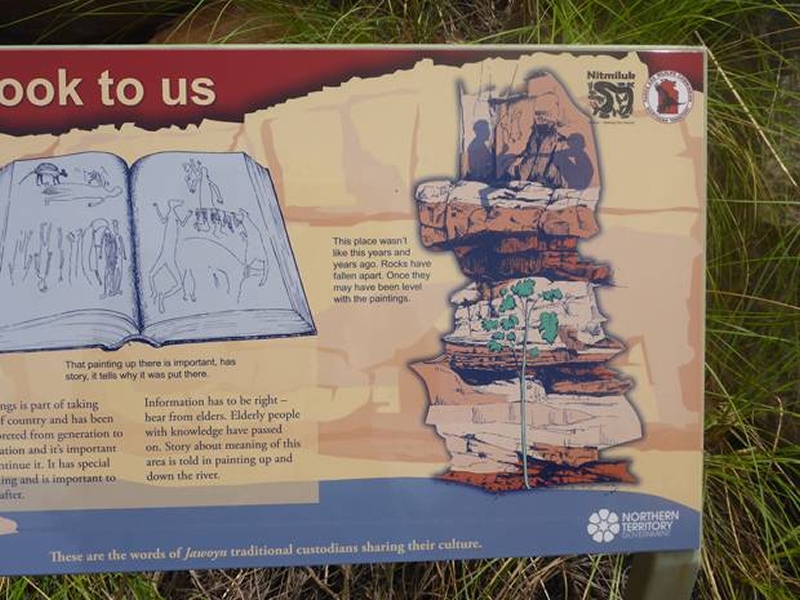
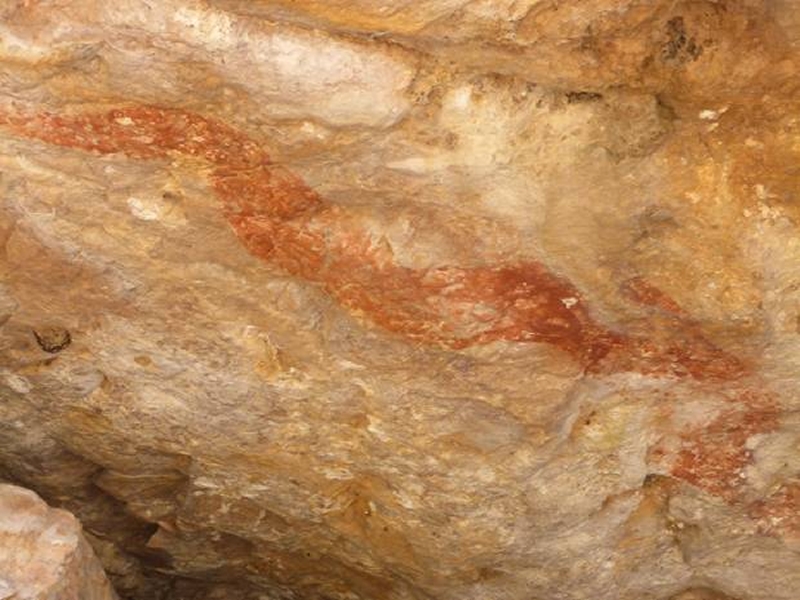
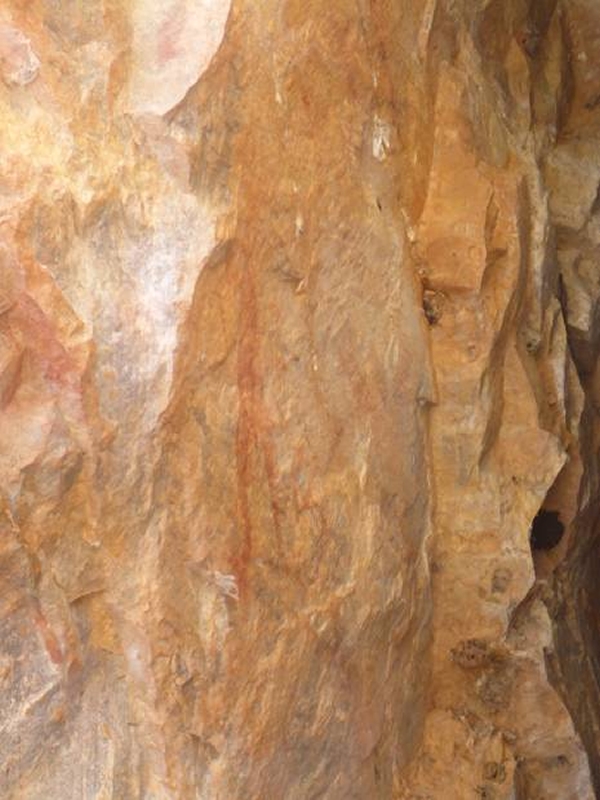
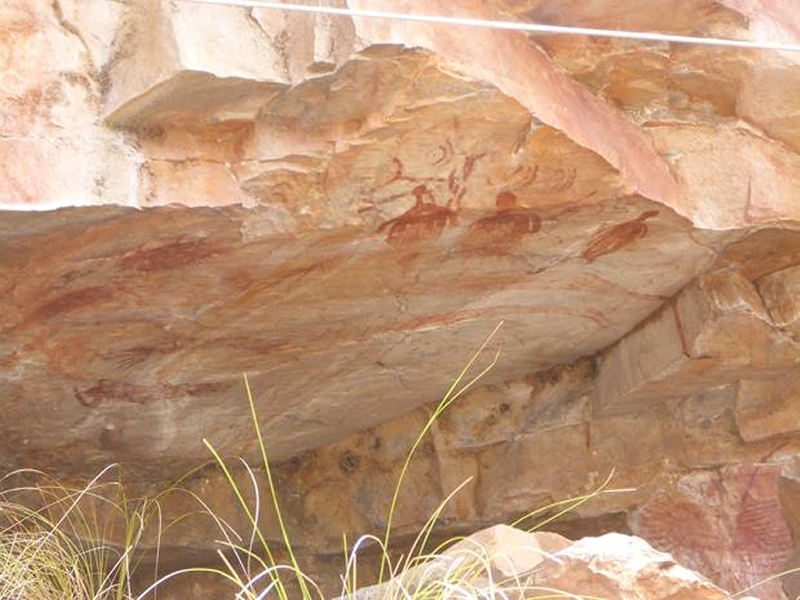
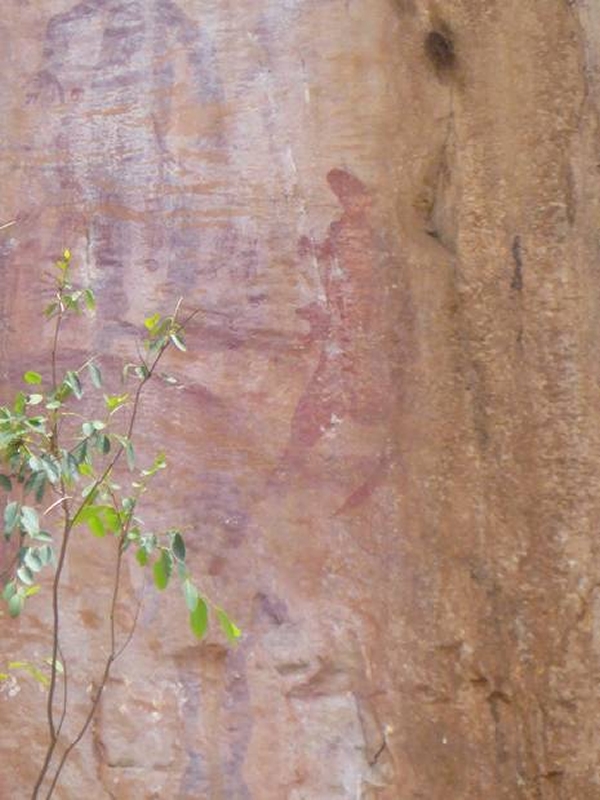
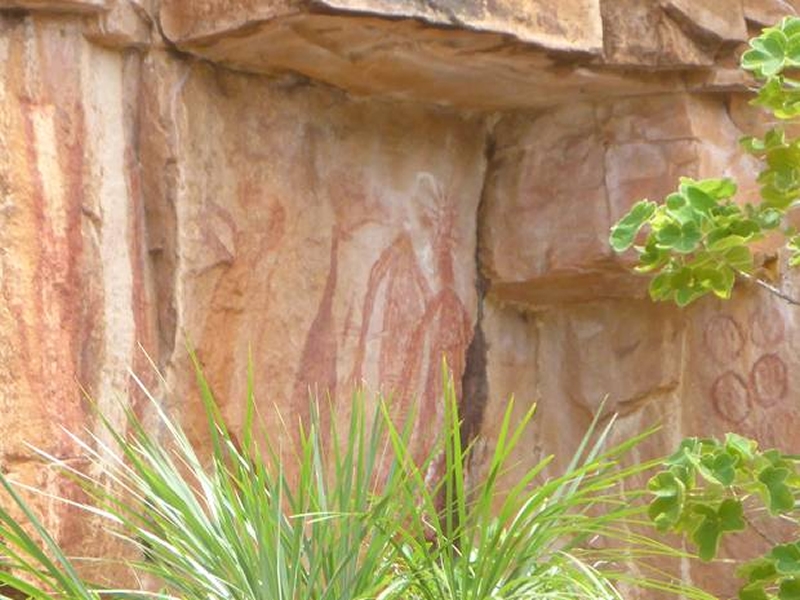

By this time we were all well warmed up, in fact we were baking, even Jamey had to remove his sunglasses and wipe the sweat from his eyes with his short sleeve. So we started on the short walk back from the gallery in a meandering line. A lady infront of us wearing thick trousers, city shoes and no hat or sunglasses suddenly stumbled, losing her heavy handbag in the process which tumbled and opened on impact, she bent a nail back and her finger started bleeding, poor thing.
Two guides helped her to a sitting position while I gathered up all her essential bits and bobs. It reminded me of my big handbag days when I carried everything including a screwdriver. I felt not only for her but also the guide who was busy completing the Incident Report. Paul, our skipper on one of our Challenger Sailing Trips once said in his initiation chat “If you are going to have an accident please make sure you die as there is so much more paperwork for an injury than an accidental death!”
